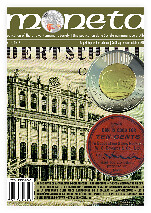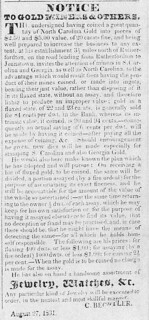
About UsThe Numismatic Bibliomania Society is a non-profit organization promoting numismatic literature. For more information please see our web site at coinbooks.org SubscriptionsThose wishing to become new E-Sylum subscribers (or wishing to Unsubscribe) can go to the following web page link MembershipThere is a membership application available on the web site Membership Application To join, print the application and return it with your check to the address printed on the application. Membership is only $15 to addresses in the U.S., $20 for First Class mail, and $25 elsewhere. For those without web access, write to: David M. Sundman, Treasurer AsylumFor Asylum mailing address changes and other membership questions, contact David at this email address: dsundman@LittletonCoin.com SubmissionsTo submit items for publication in The E-Sylum, just Reply to this message, or write to the Editor at this address: whomren@gmail.com
BUY THE BOOK BEFORE THE COIN |
- WAYNE'S WORDS: THE E-SYLUM OCTOBER 20, 2013
- ASYLUM APRIL-JUNE 2013 ISSUE PUBLISHED
- GEORGE J. FULD 1932 - 2013
- FULD'S REMINISCENCE ON CIVIL WAR TOKEN RESEARCH
- NEW BOOK: PANIC SCRIP OF 1893, 1907 AND 1914
- NEW BOOKS IN THE MONETA SERIES: #161-#166
- MONETA AUGUST-SEPTEMBER-OCTOBER 2013 ISSUE PUBLISHED
- BOOK REVIEW: MEDIEVAL EUROPEAN COINAGE, VOLUME 6
- BOOK REVIEW: A GUIDE BOOK OF CIVIL WAR TOKENS
- BOOK REVIEW: THE NATIONAL COIN ALBUM AND RELATED PRODUCTS
- ANS LIBRARY 2013 ANNUAL REPORT
- NOTES FROM E-SYLUM READERS: OCTOBER 20, 2013
- MORE ON THE 1604 HENRY IIII MEDAL
- MORE ON THE TYLER 1838-O HALF DOLLAR LETTER
- THE PAN LECTURE SERIES OCTOBER 25TH, 2013
- AUTHORS MERCANTI AND MOY AT BALTIMORE EXPO NOVEMBER 2013
- EARLY BECHTLER NEWSPAPER CLIPPINGS
- NUMISMATIC LIBRARIES AND ESTATE PLANNING
- JOEL OROSZ ON ONE-COIN COIN BOOKS
- U.S. MINT RESEARCH AT THE NEWARK PUBLIC LIBRARY
- WAYNE'S NUMISMATIC DIARY: OCTOBER 20, 2013
- THE DAVID SUNDMAN MASSACHUSETTS SILVER COLLECTION
- MAUREEN AND STU LEVINE ON NEWMAN’S ORIGINAL SILVER COINS
- CHINESE TOURISTS DETAINED IN PARIS OVER ONE-EURO COINS
- STEPPING THE MAST OF THE WHALING SHIP CHARLES W. MORGAN
- SOME STACK'S BOWERS NOVEMBER 2013 BALTIMORE AUCTION LOTS
- NUMISMATIC SURVEY OF EGYPT AND ALEXANDRIA, PART III
- EXHIBIT: REFLECTED GLORY: THE ROMANOVS, WÜRTTEMBERG AND EUROPE
- FEATURED WEB PAGE: THE FITZWILLIAM MUSEUM COIN CABINET
Click here to access the complete archive
To comment or submit articles, reply to whomren@gmail.com
WAYNE'S WORDS: THE E-SYLUM OCTOBER 20, 2013

First, thanks to David Ganz, Dave Bowers, Greg Adams and others for their kind comments on recent issues. Knowing the publication is anticipated and read helps keep me going each week.
New subscribers this week include Brian Kendrella of Stacks Bowers, and Janet Bazzone. Welcome aboard! We have 1,680 email subscribers, plus 247 followers on Facebook.
This week we open with word on the latest issue of our print journal, and sad news of the loss of another U.S. numismatic giant. Next up are announcements of two new books and the latest issue of moneta.
Other topics include the ANS Library, an 1604 Henry IIII medal, Medieval European Coinage, speakers at the PAN and Baltimore shows, the stepping of the mast ceremony, and lots from upcoming Heritage and Stack's Bowers sales.
To learn more about the Rufus Tyler letter on the 1838-O Half Dollar, an 11,000-piece collection of Civil War Tokens, and Jeremiah Colburn's Willow Tree Shilling, read on. Have a great week, everyone!
Wayne Homren
Editor, The E-Sylum
ASYLUM APRIL-JUNE 2013 ISSUE PUBLISHED
Another issue of The Asylum is at the printers. Here are the contents:
-
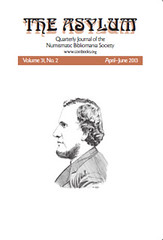 John W. Adams - Introducing Emmanuel J. Attinelli
John W. Adams - Introducing Emmanuel J. Attinelli
- John W. Adams - Numisgraphics—The Flesh and The Spirit
- Pete Smith and Joel J. Orosz - Which Came First? Childs' Views or The Casket?
- George Kolbe - Reminiscences of a Numismatic Bookseller 2
- Myron Xenos - "You Don't Say": Numismatic Quarterly Quiz
- David F. Fanning - Off the Shelf
- P. Scott Rubin - United States Auction Sales: The First Surge, Two Sales in Two Weeks in Two Cities (June 1855)
- D. Wayne Johnson - Blessed Art Thou, Bibliography
- Joel J. Orosz - The 2013 Annual Meeting of the Numismatic Bibliomania Society
- Elizabeth Hahn - The 2013 NBS Symposium: Karl Moulton and the "Franklin Hoard"
- Steve M. Tompkins - Book Review: The Draped Bust Half Dollars of 1796– 1797, by Jon P. Amato
After the long delay in assembling this oversized issue, the next two should appear relatively quickly.
And finally, thanks to Bill Malkmus, there is also an index supplement at the printers covering volumes 26 to 30 of The Asylum.
To access the NBS membership application, see: www.coinbooks.org/club_nbs_member_app.html
David Yoon adds:
According to Joel Orosz's report of the annual meeting, the dues will be changed, effective January 1, 2014 to $20 U.S. and $25 foreign. People who sign up before that date get the old rate.
GEORGE J. FULD 1932 - 2013
Tony Lopez writes:
George was not only a pioneer in numismatic and exonumia research, but also an extraordinary gentleman. George helped me with various projects over the years on historic and Indian Peace medals, and was an absolute encyclopedia. Despite the width and breadth of his incredible expertise, George was open to new ideas and discoveries and was never dogmatic about his knowledge.
I was fortunate enough to spend a day with George in 2008 visiting the Maryland Historical Society and authenticating their amazing holdings of iconic historic medals, including the original silver Comitia Americana medal awarded to revolutionary War hero John Eager Howard by the early Congress for the Battle of Cowpens, an Annapolis Tuesday Club medal, and their complete set of Maryland medals (Betts 34-36).

In the above photo from our visit that day, L-R are Jeannine Disviscour (Curator), David Menchell, Barry Tayman, George Fuld, Tony Lopez, and the late Patricia Ann Roberts (MdHS Volunteer) in front of a painting of John Eager Howard by Charles Willson Peale.
George, always generous with his knowledge and time, saw a need there at the MdHS, and after our visit contacted the MdHS and became a volunteer there, assisting them with their numismatic holdings. After our visit, We went to lunch and George went over his research on the Washington Pattern Coins of Peter Getz with Barry and me. Listening to him, I have to admit that the kid inside me was secretly thrilled. There I was, hanging out with one of my numismatic heroes - none other than George Fuld from all my Civil War token and Washington Medal catalog numbers and the same George Fuld who wrote all of those books on medals and tokens that I used all the time.
But in person George was just a regular guy, down to earth, and easy to be around. His tireless passion and dedication to advance the published knowledge of coins, medals, and tokens left behind a timeless legacy of important reference works - but what I will always remember most about George was his generosity, unselfish accessibility, kind demeanor, and more than anything his graciousness.
Joel Orosz writes:
George Fuld and his father, Melvin, built the first really comprehensive American numismatic library of the post-World War Two era, or at least the first such postwar collection to go under the auctioneer's hammer. The sales of the Fuld collection by Frank and Laurese Katen in the early 1970s paved the way for George Frederick Kolbe to begin his auctioneering in 1976, which led directly to a modern robust marketplace in numismatic literature. Beyond this enormous contribution, George Fuld was the very model of a thoughtful scholar and a thoroughgoing gentleman, a man to be admired for both his contributions to numismatic knowledge and his old-school civility.
George Kolbe writes:
George Fuld was one of my earliest customers, going all the way back to the 1960s. The sale of George's numismatic library by the Katens in 1971 would have a major impact on the course of my career as a numismatic bookseller. The finest American numismatic library to have been formed up to that time, the many rarities and the comprehensive runs of classic United States numismatic auction sale catalogues—so meticulously assembled—attracted the attention of a whole new generation of budding numismatic bibliophiles and researchers. The results of the sale changed the entire demand and price structure. Less than five years after the sale, I conducted my own first sale of numismatic literature, a modest affair to be sure, but one that met with unexpected success.
Sometime in the late 1970s I had the good fortune, via Barry Tayman, to acquire George's annotated set of the ANS Dictionary Catalogue. The auction catalogue volume of the series demonstrates George's unwavering devotion to completing the various series recorded therein. Every catalogue present in his library is recorded, along with a whole raft of sales not in the ANS Library at the time. In a sense, I have lived with the man for over three decades. The seven volumes, once nearly new, are all now shelf worn from heavy use.
All the good you may hear from others about George is true, and more. A few years ago, Alan Meghrig and I had the great pleasure to work with George in bringing to completion his work on Peter Getz patterns, based on the preliminary research of Jack Collins. A few weeks ago I spoke with George about an article I am writing. He sounded good: his mental powers and basic human decency as vibrant as ever. I will miss him. In the numismatic world a great loss is counterbalanced by a long lifetime of invaluable published numismatic research, and a life well lived.
Dave Bowers writes:
We have just lost one of the nicest people I have ever known in numismatics—a true prince. He started collecting coins in 1946 when his father Melvin (born 1901) did. He had been doing it ever since.
David Gladfelter writes:
George and his late father Melvin wrote the leading references on Civil War tokens, including U. S. Civil War Store Cards published in 1972 with a second edition in 1975, and Patriotic Civil War Tokens now in its 5th edition published in 2005. George contributed his reminiscences about CWT collecting in Dave Bowers’s book A Guide Book of Civil War Tokens published by Whitman earlier this year.
He had been in a nursing home for some time but his mind was sound – he gave me information recently over the phone about CWTs he had obtained from the Scovill Manufacturing Co., Waterbury, CT.
With permission, here is the updated entry for George Fuld from Pete Smith's American Numismatic Biographies. Thanks, Pete!
Fuld, George J(oseph) Author (b. 11/8/1932 d. 10/19/2013)
Born in Baltimore, Maryland; son of Melvin. Married in 1955 with three children; married to Doris in 1969. Received an Sc.D. from the Massachusetts Institute of Technology. Consultant with Fuld Brothers 1954 to 1960 and vice president 1960 to 1963. Employed in radiation research with Goodyear Tire Company 1963 to 1967. George and Doris were owners of Dorge Approvals in the token and medal and philatelic business. Dorge Approvals conducted 13 auction sales from 1972 to 1976.
He served as president of the Society of Tokens, Medals and Obsolete Paper Money in 1960 to 1962. He was also editor of the TAMS Journal 1960 to 1962. He was honored by TAMS with a medal struck by the Medallic Art Company. His library was sold at auction by Frank and Laurese Katen August 15, 1971. In 1980 he became auction manager for Bowers and Ruddy.
Received ANA Medal of Merit (1961, Lifetime Achievement Award (2002) Numismatic Hall of Fame (2008). Honored in Civil War Token Society Hall of Fame (2007),. NBS Armand Champa Award (1993), MCA Carl Carlson Award (2004).
To visit the funeral home page for George, see: George J. Fuld (www.sollevinson.com/notice.php?lr=loc&id=22822)
Dave Bowers is coordinating a memorial page to be published in Coin World. The cost will be divided equally among those friends and fans of George who would like to be listed. If this is of interest you are invited to e-mail Dave at qdbarchive@metrocast.net giving a subject line in your e-mail: George Fuld Memorial.
Please do this before Wednesday. Dave will bill you once the cost is determined. It will be in the tens of dollars. State how you would like your name listed: casually as Bill, formally as William, or Mr. and Mrs. or whatever. Dave would also like to find several good photographs of George.
FULD'S REMINISCENCE ON CIVIL WAR TOKEN RESEARCH
As of 1943, like many youngsters I started to collect Lincoln cents. By 1946 I was deeply involved in collecting all United States coinage, and had completed my Lincoln cent set as well as a set of Indian Head cents and was pursuing earlier years of this denomination. In 1947 I talked my father, Melvin Fuld, into taking me to the American Numismatic Association convention held that year in Buffalo. For a precocious kid of fifteen, this was such an eye-opening experience. I met two collectors who made a complete change in my collecting interest. They were William Guild of West Newton, Massachusetts (later Florida) and Bill Jacka of Bedford, Ohio. They both told me of a new collecting interest—Civil War tokens. They suggested that this was a wide open field with hundreds of different tokens available at 10 to 25 cents each.
At the show I met David Bullowa, who sold me dozens of different Civil War tokens at twenty-five cents each. At that time, my father had no interest in coin collecting. Over the next year or so he joined me in enjoying these tokens. In 1949, Bullowa acquired the 4,000 plus collection of Civil War tokens formed by Joseph Barnet and advertised in The Numismatist. He wanted $2,500 for the collection, a “huge” sum for me at the time. I proposed that Bullowa buy my United States collection of cents complete from 1794 to date (except the 1856 Flying Eagle) as partial payment in the amount of $900. My father agreed to make up the difference in cash. We packed up our collection and drove from Baltimore to Philadelphia to make the trade.
At that time the only reference available was the Hetrich and Guttag book published in 1924, Barnet had published an updated commentary on H&G varieties in The Numismatist and The Numismatic Review in 1943 and 1944. I aggressively continued to buy Civil War tokens, including small collections, and offered duplicates for sale. In 1951 my father and I bought the D.C. Wismer Collection of Civil War tokens, consisting of 11,000 pieces, from the New Netherlands Coin Company, at six cents each. We sold over 5,000 of these, packed in a wooden crate, to Tatham Stamp & Coin Co. in Springfield, Massachusetts. These were all duplicates, mainly the “Dix” patriotic tokens.
The other major collection we acquired was Henry Guttag’s collection of about 5,000 pieces in 1958. It had first passed to Max Schwartz of New York City, who retained a hundred or so pieces, then to John Zug of Bowie, Maryland, who advertised it, but no buyer came forth. From there it went to New Netherlands, then to us. We traded with the few serious Civil War token collectors such as William Fayerweather, Clif Temple, Jim Curto, Ray Haggenjos, Charles Foster, Lionel Rudduck, Wayne Rich, Martin Jacobowitz, and Otto Kersteiner.
Starting about 1951 my father and I created articles on special series of Civil War tokens. About the same time I proposed a comprehensive compilation. I chose to do the patriotic series first, as there are only about 550 different patriotic token dies. Each die combination was assigned a number, as had been done by Hetrich and Guttag. I assigned rarity ratings of 1 to 10, which are still used today. The rarity of each combination was determined by checking inventories of all collections I knew of plus my experience of the many duplicates that I had seen.
The photographs of each die were taken at 2X by Kenneth Bressett, after which I pasted and numbered them on 22 plates. This work was published serially in 1959 in The Numismatic Scrapbook Magazine, edited by Lee Hewitt, and in 1960 as one of the “little black books” which Hewitt printed for the Whitman, then located in Racine. Two more editions were sold by Whitman Publishing Company, with a total run of over 15,000 copies at one dollar each.
Concurrently with the patriotic work, I was busy with a book covering the 8,500 or so store card varieties. In 1962 Whitman published A Guide to Civil War Store Card Tokens as another of its “little black books.” State by state, each city in which merchants issued Civil War tokens was assigned a number from 1 to 1,000, following the style of Atwood’s Catalogue of United States and Canadian Transportation Tokens published by the American Vecturist Association. The issues of the 900 or so store card advertisers were listed by merchant followed by a number representing the die varieties known of each advertiser. There were only occasional illustrations.
Starting about 1962 my father and I began working on a detailed catalog of store card varieties with photographs of the obverse die or dies used by each advertiser. As many dies were used repeatedly for token reverses, a new list of stock reverse dies with identification numbers starting with 1000 was prepared. One must remember that in 1962 there were no computers or word processors and of course no Internet.
Starting about 1970, Doug Watson (who worked for Krause Publications) photographed all tokens at 2X size and made paste-ups by hand of the descriptive text and photos of each token. The preparation of this massive text took about two years of time by Watson and me. The book was in large format 8½ x 11 size totaling 350 pages. I assigned copyright to the Civil War Token Society and it was printed by Krause in 1972. As I recall 1,000 copies were printed which sold out promptly. A slightly revised second edition was printed in a reduced format of 6 x 9 inches by Al Hoch of Quarterman Publications.
Along the way, in 1967, there was enough collector interest for the formation of the Civil War Token Society with Melvin Fuld as its the first president. From a small group of about 100 the Society grew to over 1,000 members. Its journal was and is state of the art in publishing research, news, and other information.
By about 1970 my collection had grown to include about 6,500 different tokens. As new acquisitions were few and far between, I decided to sell it, mostly in groups by states. Now, over 40 years later, with updates on the patriotic and store card books and with interest increased by the Internet and other means, we have information that I never dreamed of in the 1940s, 1950, and 1960s. It has been a pleasure to have been a part of this growth.
NEW BOOK: PANIC SCRIP OF 1893, 1907 AND 1914
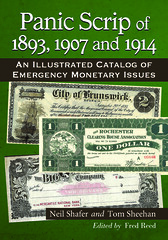
An Illustrated Catalog of Emergency Monetary Issues
Neil Shafer and Tom Sheehan
Edited by Fred Reed
416 pages
$75 softcover (7 × 10) 2013
808 photos, appendices, bibliography, index
ISBN 978-0-7864-7577-3 Ebook ISBN 978-1-4766-0570-8
This extensively illustrated work catalogs all known U.S. emergency currency issues of the panics of 1893, 1907 and 1914. Nearly 900 photographs show most types of these privately produced substitutes for money. The book also includes contextual historical information and authoritative appendices by Steve Whitfield on labor scrip and Loren Gatch on the background leading to these currency issues.
Neil Shafer has been a professional numismatic cataloger and author for more than 50 years and has been inducted into the American Numismatic Association and the International Bank Note Society Halls of Fame. He writes monthly for Bank Note Reporter. Tom Sheehan is a longtime coin collector and an avid researcher of Washington State numismatics who studies and collects panic scrip. Fred Reed has been an editor of both Paper Money and Coin World magazines. He lives in Dallas.
McFarland & Company, Inc., Publishers
Box 611
Jefferson, North Carolina 28640
336-246-4460
Orders 800-253-2187
FAX 336-246-4403
www.mcfarlandpub.com
In Europe, Australia, Asia and Africa, order from: www.eurospanbookstore.com/mcfarland
NEW BOOKS IN THE MONETA SERIES: #161-#166
In the series Trouvailles et tresors monetaires en Belgique (J.-L. Dengis)
Moneta # 161, XVII. Province de Flandre Occidentale (Du moyen âge à 1794), 150 p. www.moneta.be/volumes/moneta_161.htm
Moneta # 162, XVIII. Province de Flandre Orientale (Du moyen âge à 1794), 200 p. www.moneta.be/volumes/moneta_162.htm


In the series Documents and Studies on 19th c. Monetary History
Moneta # 163, International Monetary Conferences, Republication of Ministère des Affaires Étrangères, Conférence monétaire entre la Belgique, la France, la Grèce, l'Italie et la Suisse en 1885, Convention et Procès-verbaux (Paris, 1885), VI+324+4* p. www.moneta.be/volumes/moneta_163.htm
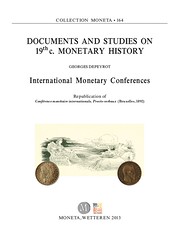 Moneta # 164, International Monetary Conferences, Republication of Conférence monétaire internationale, Procès-verbaux (Bruxelles, 1892), X+440+4* p.
www.moneta.be/volumes/moneta_164.htm
Moneta # 164, International Monetary Conferences, Republication of Conférence monétaire internationale, Procès-verbaux (Bruxelles, 1892), X+440+4* p.
www.moneta.be/volumes/moneta_164.htm
Moneta # 165, International Monetary Conferences, Republication of International Monetary Conference, Brussels, 1892, Instructions to the Delegates of Great Britain and their report together with the Proceedings of the Conference (London, 1893), X+236+4* p. www.moneta.be/volumes/moneta_165.htm
Moneta # 166, International Monetary Conferences, Republication of Conférence monétaire entre la Belgique, la France, la Grèce l'Italie et la Suisse en 1893, Arrangement et procès-verbaux (Paris, 1894), VI+148+4* p. www.moneta.be/volumes/moneta_166.htm
Moneta (Wetteren, Belgium) publishes volumes on numismatics, monetary history, coin finds, from Antiquity to present times, in various languages. Catalogue on www.moneta.be .
MONETA AUGUST-SEPTEMBER-OCTOBER 2013 ISSUE PUBLISHED
The newest edition of moneta is now online at www.ons-sno.ca.
- The birth of a 2-dollar coin [Serge Pelletier]
- Winnipeg 2013 - RCNA convention report [Steve Woodland]
- Architecture Serge Pelletier]
- An Ottawa Senator issues tokens [Chris Faulkner]
- The commemorative coins of the Fifth Republic, Part 3 - 5-franc coins [Wilfred Lauber]
- Royal Bank of Canada’s “Penny Pinchers” [Ron Cheek]
- 10 cents 1967: Making the difference [Colin J. Courtney Mustaphi]
Enjoy!
To view the issue online, see: http://www.ons-sno.ca/
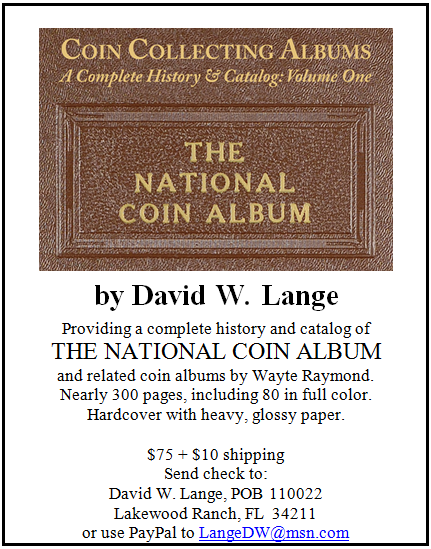
BOOK REVIEW: MEDIEVAL EUROPEAN COINAGE, VOLUME 6
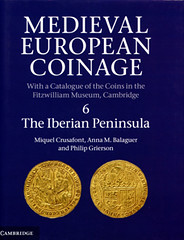 Miquel Crusafont, Anna M. Balaguer, Philip Grierson. Medieval European Coinage. Volume 6: The Iberian Peninsula.
Miquel Crusafont, Anna M. Balaguer, Philip Grierson. Medieval European Coinage. Volume 6: The Iberian Peninsula.
Cambridge University Press.
Cambridge 2013.
929 p. 136 fig. 41 pl. 25 x 20 cm.
Hard cover.
ISBN 9780521260145.
150 pounds.
MEC – Medieval European Coinage – the abbreviation reminds a bit of RIC, RPC, or in short of all these monumental corpora which have scientifically catalogued the whole coinage of a certain epoch. As its name reveals the MEC is entirely dedicated to the Middle Ages hence to the epoch between c.450 and 1500 CE. Eventually, the project should consist of 20 volumes of which the third has now been published. It covers the Iberian Peninsula on 886 pages and 60 plates.
Nine chapters give all information we possess today on numismatics of medieval Spain. After a short introduction into the historical background and numismatics follows a section on money circulation in the peninsula. Then the issuing key figures are presented, the Muslim realms, the Carolingians, the Kingdom of Catalonia and Aragon, Mallorca, Navarra, Castile and Leon, and, in the end, Portugal. All chapters are organised analogously. They start with a comprehensive bibliography, then follows a list of the mints and, at the end, the coins are discussed according to smaller geographical, political or chronological sections.
It goes without saying that this is no book for a light read. At least after half an hour one’s head is spinning because of all the details meticulously put at the right place. But every one who needs to look for something cannot avoid the MEC.
Anyway, most coin dealers and museum curators will just settle for the wonderful ‘picture-book’, the plates at the end of the volume. The coins of the Iberian Peninsula in the gigantic collection of medieval coins at the Fitzwilliam Museum are listed there. And the list goes from 1 to 1131, a real paradigm of lucidity! Every single coin is photographed with a description right beside. Thanks to that even a beginner will find the kingdom, ruler and mint of his coin by looking at the images. Well, let’s be honest, you must take a very close look indeed, if you want to distinguish the many variations. However, this type corpus is a very big help for the difficult task of describing a coin!
Comprehensive concordances for the most important reference works and thorough indices conclude this book that must be part of EVERY library whose owner intends to deal seriously with medieval numismatics.
Finishing this review I must remember two men. They are responsible that this project of generations has not been given up. Philipp Grierson, who has received the well-earned honour of being mentioned seven years after his death as co-author besides the famous specialists Miquel Crusafont and Anna M. Balaguer. He had the vision of collecting European medieval coins in the post-war period when virtually no one was interested in this stuff and, hence, even a professor at Cambridge could afford those coins. Philipp Grierson donated over 20,000 objects – today worth some millions – to the Fitzwilliam Museum in 1976. Thanks to this huge collection the MEC has no problems with images for these volumes.
To read the complete article, see: MEC Volume 6 published (www.coinsweekly.com/en/News/4?&id=2341)
BOOK REVIEW: A GUIDE BOOK OF CIVIL WAR TOKENS
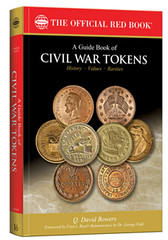 Book Review: A Guide Book of Civil War Tokens by Q. David Bowers
Book Review: A Guide Book of Civil War Tokens by Q. David Bowers
By Steve Bishop
Years ago, I had amassed a pretty good collection of Civil War tokens, including some rare varieties and off-metals. I regret selling it (at the time I needed the money), because now, Q. David Bowers has written a well-composed and interesting book on the series, which is bound to increase the popularity (and prices) of examples of these historically fascinating bits of commerce.
In brief, Civil War tokens were a consequence of the shortage of hard money during the war, in which paper money drove most circulating coinage out of circulation, silver and gold especially, but also including copper and copper-nickel. Enterprising merchants issued the cent-sized tokens as change, having bought them from suppliers at less than one cent each, thereby making a profit. If the merchant’s name was not included on the piece, they couldn’t be redeemed, but typically circulated widely.
Tokens not issued as advertising pieces (store cards) generally had a patriotic theme, and while the store cards were meant as advertising, they too sometimes expressed the merchant’s patriotism. Many of the pieces imitated the size and design of the Indian cent, and some were marked “Not One Cent” to avoid charges of counterfeiting. Even so, their distribution was outlawed in 1862 under the same law that authorized use of postage stamps as money, but that ban had little effect, and more tokens were issued in 1863 than in any other year. A later law in 1864 was more effective.
There are over 10,000 varieties of Civil War tokens, and this book does a pretty good job of cataloguing the dies and merchants that make them up. To be able to fully attribute all of the tokens you may encounter, you need the standard in the field, the volumes on Patriotics and Store Cards by George and Melvin Fuld, but this is a good book for both the casual and serious collector, because you can probably correctly identify most of them. For a casual collector, this book is probably enough, and for the serious collector, this is a good “take-along” book when you don’t want to lug around the several pounds of the Fuld references.
There are two really great things about this book:
1) The pictures of the patriotic and store card dies are in color, which makes for a really beautiful presentation, since the pictures included are generally of very high condition pieces.
2) David Bowers is one of the best popularizers of numismatics, and is one of the few people who is both a true expert on Civil War tokens (he has an extensive collection and has studied them for years) and an excellent writer. He provides extensive historical background that is missing from many catalogs of exonumia.
The historical information in this book makes it a good read for Civil War buffs, people interested in economic history, and people generally interested in numismatics. It includes a listing of the engravers and die sinkers who produced the dies, as well as an appendix that briefly covers encased postage stamps, which also circulated as small change during the War Between the States. The cost is a fraction of what you would pay for the Fuld references, and it actually makes good bedtime reading. Highly recommended.
First, I appreciate the short appendices. One covers Encased Postage Stamps, which are closely related to CWTS. Others list tokens included in the earlier Fuld books, but now believed not to be contemporary to the Civil War. My favorite though, is Appendix I, which gives short bios of Selected Civil War Token Engravers and Coiners.
On the down side, the storecard listings are extremely brief, but of course this is all such a guide book will allow; providing much more information about each token would result in a mammoth work. But the book is right on target for carrying to shows for quick reference.
I do like the grid format of color images of stock reverse dies. The color photos throughout are marvelous; as Steve notes, they are of high condition specimens and many dazzle the eye.
My favorite chapter (and one most bibliophiles will appreciate) is Chapter 4: Civil War Tokens and the History of Collecting Them. This could easily be expeanded to a book-length treatment someday. Included is the first known published numismatic study of the series, the Pliny E. Chase monograph published in 1863. It's a very rare item I'm proud to have in my numismatic library.
Of course, the reminiscence of George Fuld is hugely important to numismatic history, and makes an apt starting point for this long-awaited book. It's certainly one I will make room for on my library shelves. -Editor
Dennis Tucker of Whitman Publishing adds:
Dave’s new Civil War tokens book is a runaway. We actually sold out at the Chicago ANA and had to have more boxes shipped up from our warehouse during the show!
To read the earlier E-Sylum article, see: NEW BOOK: A GUIDE BOOK OF CIVIL WAR TOKENS (www.coinbooks.org/esylum_v16n42a03.html)
BOOK REVIEW: THE NATIONAL COIN ALBUM AND RELATED PRODUCTS
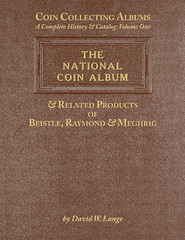 I can't resist writing a few lines in response to David Lange's new book, Coin Collecting Albums. A Complete History and Catalog: Volume One. This first volume, which I received only a few days ago, focuses on the National Coin Album and related products made by the Beistle Company, Wayte Raymond, and M. Meghrig & Sons. Coin albums, especially in the pre-slab era, were the unsung heroes in the growth of coin collecting in America. Not only did they provide a convenient way to store one's collection, they urged the collector on--it became almost an obsession to fill the empty holes in the albums.
I can't resist writing a few lines in response to David Lange's new book, Coin Collecting Albums. A Complete History and Catalog: Volume One. This first volume, which I received only a few days ago, focuses on the National Coin Album and related products made by the Beistle Company, Wayte Raymond, and M. Meghrig & Sons. Coin albums, especially in the pre-slab era, were the unsung heroes in the growth of coin collecting in America. Not only did they provide a convenient way to store one's collection, they urged the collector on--it became almost an obsession to fill the empty holes in the albums.
David Lange's new volume is four books in one. First, it is a thorough catalog of the different types and varieties of coin albums, buttressed, when possible, by extensive research in the surviving archives. Second, it creates a new numismatic collecting specialty (finding some of the rarer albums is every bit as difficult--although still much less expensive--than finding the coins they were manufactured to hold). Third, it is a book about numismatic literature, for it is impossible to talk about Beistle and Raymond coin albums without discussing the literature these men also produced. Fourth, it provides a snapshot of American numismatics from the roaring 20s through the Cold War, all lavishly illustrated with photos and ads from that eventful period.
Those who know David personally will not be surprised by his trademark combination of careful scholarship and sprightly writing. If you haven't read any of his books before, I strongly urge you to give this one a try. Fair warning, though--you will no doubt discover, before you get too far into it, that you simply cannot live without a few National Albums around the house!
To read the earlier E-Sylum article, see: NEW BOOK: THE NATIONAL COIN ALBUM AND RELATED PRODUCTS (www.coinbooks.org/esylum_v16n41a04.html)
THE BOOK BAZARRE
ANS LIBRARY 2013 ANNUAL REPORT
The library continues to have a healthy stream of visitors working their way through the collections; from local members and residents to scholars from all over the world. Reference requests still remain one of our top activities, and as in previous years, the majority come through via email (from all over the world).
I would like to start by thanking a handful of individuals who stepped up this fiscal year to help with the library cataloger fund, including: Dan Hamelberg, the Numismatic Bibliomania Society, Sydney Martin, Larry Schwimmer, William A. Burd, Len Augsburger, Tom Harrison, and John P. Huffman. As a result of this, coupled with the donations from last year, we were able to hire a new full-time library cataloger, Katie Rissetto. She has been excellent – efficient, quick, curious, and good-humored, and she has adapted quickly to working at the ANS.
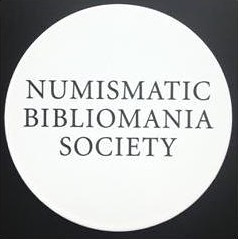 We do still need to raise funds to keep this position going so I hope we will be able to meet our goal again this year. We also had significant contributions to the library funds from John W. Adams, Rick Witschonke, George Kolbe, David Fanning, Joseph Foster, and David Andreas. We also have the honor of adding another name to our wall of library donors. This year, we honor the Numismatic Bibliomania Society!
We do still need to raise funds to keep this position going so I hope we will be able to meet our goal again this year. We also had significant contributions to the library funds from John W. Adams, Rick Witschonke, George Kolbe, David Fanning, Joseph Foster, and David Andreas. We also have the honor of adding another name to our wall of library donors. This year, we honor the Numismatic Bibliomania Society!
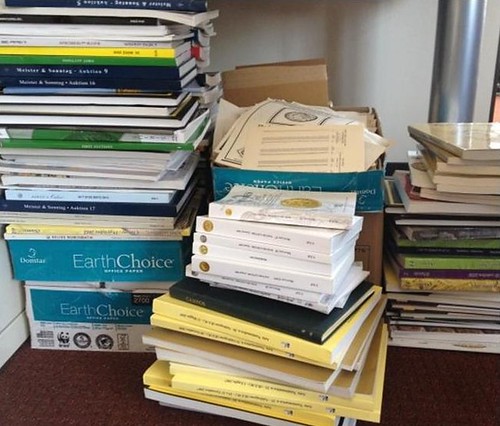
Auction catalogs!
We received nearly a THOUSAND auction catalogs in response to posting and circulating our lists of “missing” catalogs over the last year. We are particularly grateful to the following individuals for their outstanding support in this area: Rick Witschonke, Normand Pepin, John Keeberg, Rachel Lyubovitzky, Danil Fishteyn, Jere Bacharach, and Heritage and the Teich Family, who were all responsible for the largest groupings of these catalog donations. A significant number of book and catalog donations also came in from: Jonathan Wohl, Mark Tomasko, Tim Welo, Ray Williams, William A. Burd, and so many more; many of these came in from items I had listed on the ‘wish list’ portion of the library. We also received more than double the amount of book donations compared to last year (376 this year compared to 185 last year!). These numbers also do not reflect the numerous pamphlet file and offprint donations. So all told, it was an excellent year for the growth of the library collections.
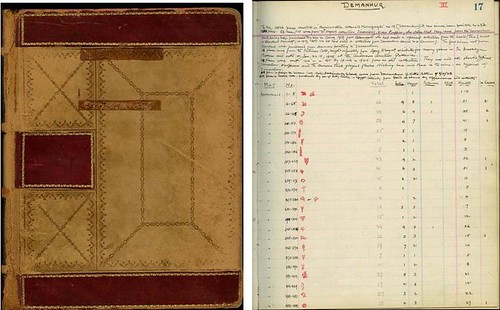
Edward T. Newell Notebooks
n June 2013, we received an Archive grant to start digitization in ARCHER, from the Gladys Krieble Delmas Foundation. The project will digitize pages from the notebooks of Edward T. Newell and will fund the staff needed to catalog the material at document level and prepare it for display in ARCHER (the online database of the ANS Archives). We have selected an initial sample of 3,000 pages, which have been chosen based on their variety of content and will allow us to test multiple levels and functions of the cataloging. Again, this project is currently underway and I look forward to reporting on it in more detail in the coming year.
To read the complete report, see: FY 2013 Annual Report (numismatics.org/FY2013/Library)
Elizabeth adds:
We had a great ANS annual meeting Saturday and there were a number of NBS members in attendance. We honored the NBS support with a plaque in the library reading room and I'm attaching here a photo of me and NBS past president Dan Freidus. It was hard to really see the donor plaques in the photos because of the white wall, but we are standing on either side of the NBS plaque.

NOTES FROM E-SYLUM READERS: OCTOBER 20, 2013
Smithsonian Numismatic Exhibit Ideas
Howard A. Daniel III writes:
There was a recent request in The E-Sylum to assist the Smithsonian in selecting pieces from the National Numismatic Collection for exhibit. I have been thinking about this for a while and decided on three areas:
1. The first coin(s) minted in the colonies that became the U.S. should be exhibited.
2. The first coin(s) minted for a U.S. colony (Philippines?).
3. The U.S. Trade Dollar, which was the only U.S. coin minted for use outside the U.S..
4. The U.S. 100 Dollar notes, which have more circulating outside the U.S. than inside the U.S.
I hope the above are worthwhile suggestions for the exhibits.
To read the earlier E-Sylum article, see: QUERY: INPUT FOR NEW SMITHSONIAN NUMISMATIC EXHIBIT SOUGHT (www.coinbooks.org/esylum_v16n39a11.html)
The New $110 Bill
Last week I wrote:
"Scott Barman discussed the release of the new U.S. $110 bill in his October 10, 2013 Coin Collector's Blog."
Greg Adams writes:
$110 bill.. Can I get a couple?
Dave Bowers writes:
There is a rule: The most obvious typo will be discovered upon reading the final published work! Inviolable! Join the group!
To read the earlier E-Sylum article, see: BEP RELEASES NEW 2013 $100 BILL (www.coinbooks.org/esylum_v16n42a25.html)
On Numismatic Indexes
Serge Pelletier writes:
I'd like to thank everyone who has submitted something on this topic. I had checked the Canadian Numismatic Index and George Cuhaj had directed me to DONUM. Unfortunately, both are incomplete. For instance, no one lists articles published in the Canadiana column in World Coin News.
To read the earlier E-Sylum article, see: MORE ON NUMISMATIC INDEXES (www.coinbooks.org/esylum_v16n42a10.html)
Query: Information on 1980s Salvadoran Gold Coin Hoard Sought
From Chile, Roberto Jovel writes:
I am presently writing a book on the history of the Salvadorian Colon, from its birth in 1892 through its demise in 2001. I have a gap in information that I wish to solve. It relates to the finding of a hoard of US Gold coins in the 1980s which eventually found its way to the US. Would E-Sylum readers be able to provide newspaper articles or any other references to that matter? I thank you in advance for any assistance on this.
MORE ON THE 1604 HENRY IIII MEDAL
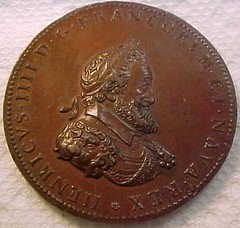
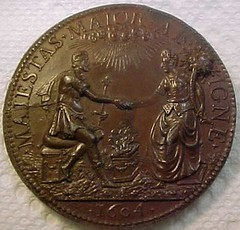
Regarding Michael Sanders' 1604 Henry IIII medal, Rick Stroman writes:
I found out a similar medal was auctioned at Baldwin's auction of the Michael Hall Collection in Miami, FL on May 4/5, 2010 as Lot 279 for a realized price of 220 pounds($351.00 USD). A copy of the catalog page with price realized written is attached.

Tony Lopez writes:
This 1604 medal is generally described in recent auctions as a generic medal of Henri IV and his wife Marie De’Medici, done by Phillipe Danfrie the younger. The medal is seen with two obverses both featuring a laureated and cuirrased bust of Henri IV in profile facing right, with the surrounding legend HENRICVS IIII DG FRANCORVM ET NAVA REX as seen in this undated obverse medal owned by Michael Sanders.
The differences in the other obverse are that it has a 1604 date below the bust, drapery, and larger lettering using NAVAR vs. NAVA. From what I can tell, the 1604 dated obverse is the original obverse, and the undated obverse is a later copy restrike die from the late 18th/early 19th century. In fact, late 20th century restrikes of this design continued to be struck using the undated obverse design; I have seen silver and bronze copies of these sell for about 100€ and 20€ respectively.
The reverse of the medal has the legend MAIESTAS MAIOR AB IGNE (Majesty greater than the fire) surrounding above an allegorical design of King Henri IV holding a scepter, sitting across from his second wife Queen Marie De’ Medici holding a cornucopia, face to face and holding hands over a flaming votive alter below the clouds and heaven above, and date 1604 in exergue below.
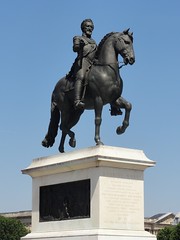 It is difficult to say what this medal, dated 1604, was intended to specifically commemorate. I have found early descriptions stating that the medal was intended to make the public aware of the Queen’s generosity; and thus the cornucopia may be an allegorical representation of her wealth or generosity. Marie De’ Medici was from the powerful banking and finance House of Medici family, and there was a dowry of 600,000 crowns when she married Henri IV in 1600. In terms of specifics, I could not find anything pertaining to a 1604 date other than her part in the commissioning of an equestrian statue of Henry IV at Pont Neuf.
It is difficult to say what this medal, dated 1604, was intended to specifically commemorate. I have found early descriptions stating that the medal was intended to make the public aware of the Queen’s generosity; and thus the cornucopia may be an allegorical representation of her wealth or generosity. Marie De’ Medici was from the powerful banking and finance House of Medici family, and there was a dowry of 600,000 crowns when she married Henri IV in 1600. In terms of specifics, I could not find anything pertaining to a 1604 date other than her part in the commissioning of an equestrian statue of Henry IV at Pont Neuf.
Pont Neuf is now the oldest bridge crossing the Seine in Paris. The statue, completed in 1618 (after Henri IV's death in 1610) was destroyed during the French Revolution, but was replaced in 1818 and still stands today. The most significant historic event which occurred in 1604 for Henry IV was the Peace Treaty made with Sultan Ahmet I and the Ottoman Empire, so this could explain the reverse legend as well - but I could not locate any contemporaneous references supporting this.
Another possibility, given the Votive Altar, was that the medal was referring to the religious strength of the Monarchy or its connection to Catholicism, the Vatican and God. Henry IV, originally a Calvinist, twice converted to Catholicism, and Marie came from The House of Medici which was a great benefactor to the Vatican. Four members of the Medici family rose to the Papacy, including Leo XI who became pope the following year on April 1, 1605; though he died only 26 days later. Between the three possibilities, perhaps a combination of the queen's generosity, and the Monarchy's Catholicism and connection to God is being celebrated by this medal.
Michael Sanders' example of the medal does not ring, so I would venture a guess that it is a copper lead filled electrotype, explaining the pristine copper finish; but could not be certain without it in hand. As far as value for struck examples, the Baldwin’s May 10, 2010 Michael Hall collection had three examples of this medal, lots 278-280, all listed as later 18th-19th century restrikes. Lot 278 in silver (1604 dated) realized £540, Lot 279 in bronze (dated) realized £220, and lot 280 (undated) realized £90. A Stacks - Coin Galleries October 2010 lot 2839 example in silver which was likely a later restrike realized $402.50.
It is noteworthy that that same silver Lot 278 medal that sold at Baldwins in the Michael Hall collection for £540 was subsequently sold later that same year in the December 11, 2010 Jean Elsen Auction 107 as Lot 1319 (listed as 58 mm diameter by Baldwin’s and 56 mm by Elsen but easily identified as the same piece by the number “XVI” marked on the edge), and realized 2200€. (In dollars, that is $872 vs. $3010, a nearly 350% increase in auction price in seven months!) With this startling jump in result, it could be that bidders determined that this silver example was a more valuable original early 17th century strike, though I don't know myself.
I have attached 3 images of medals I found, the silver Michael Hall medal dated 1604 on the obverse (from Elsen), a copper holed 1604 dated piece (from MA Shops but I don't remember where), and a 20th century Paris restrike with a 1970 edge mark from an old eBay listing. The 4th pic is of the Henry IV equestrian statue at Pont Neuf.
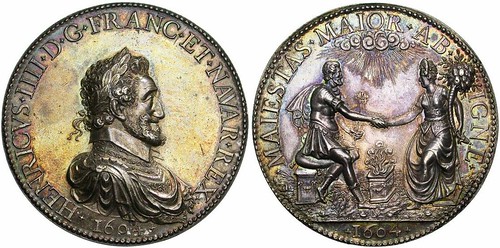
Elsen-Baldwin's silver Henry IV
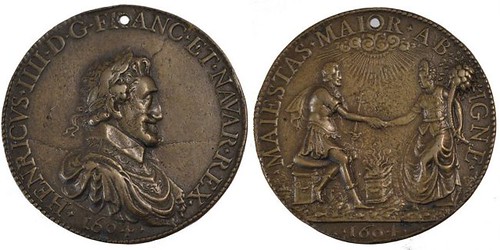
1604 dated copper
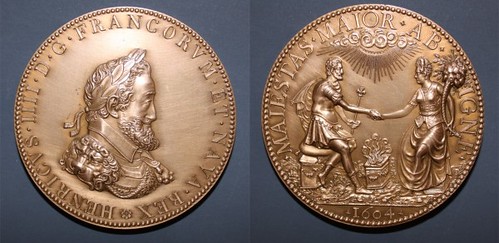
circa 1970 restrike
To read the earlier E-Sylum article, see: 1604 HENRY IIII MEDAL INFORMATION SOUGHT (www.coinbooks.org/esylum_v16n42a18.html)
THE BOOK BAZARRE
MORE ON THE TYLER 1838-O HALF DOLLAR LETTER

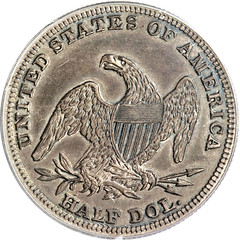
Lot 2310 Heritage 2008 April Rosemont, IL Sale
You were very helpful in publishing my letter last year about the search for the lost Rufus Tyler letter, so I thought you might like to know the results of my two year search.
The reason I wanted to try to find the Tyler letter was to reunite it with the 1838-O half dollar it was wrapped around when " discovered " in 1894. It is now known that this specific coin is unique as it is the only surviving 1838-O half that was actually produced at the New Orleans Branch mint. All 8 other specimens were test strikes done at the Philadelphia mint prior to shipping the dies to New Orleans ( ref: "The Surprising History of the 1838-O Half Dollar" by David Stone and Mark Van Winkle...pub Jan 2012 ).
I was perplexed by a number of inconsistencies in the historical record that indicated the note was given to Augustus Heaton sometime after he purchased the coin from William Friesner (sale managed by Ed Frossard) in June 1893.
How did the coin and note manage to stay together for 55 years without either being separated or "discovered" as the origins of the 1838-O were one of the greatest mysteries of 19th century numismatics ?
Why was the note published in July 1894 by Ed Frossard AFTER Augustus Heaton bought the coin, and only then passed on to Heaton?
Here is the sequence of events that makes sense from my two years of research.
1838....The 1838 -O half dollar dies are produced in Philadelphia, and ten test sample coins are produced. They are approved by Mint Director Patterson, the samples are placed in the mint safe and the dies begin their long trip to New Orleans. They arrive late and the New Orleans mint is fully occupied producing half dimes and dimes. Production of half dollars is delayed.
Jan 1839 ....Rufus Tyler produces ten samples of the 1838-O half but the reverse die is loose and he is unable to produce any more . The dies are destroyed shortly thereafter, as the mint already has the 1839 dies on hand. The coins he has made show die rust and distinct double striking on the reverse from the loose die. This makes them easily identifiable vs. the perfect Philadelphia produced samples.
June- Nov 1839 ....Tyler makes a trip to Philadelphia to bring 1839 New Orleans production samples to Director Patterson. He also brings one 1838 half with him, but Patterson does not need this sample as he already has 10 trial strikes in his safe. Patterson directs Tyler to write a presentation note to go with the 1838 sample to be given to his good friend Alexander Bache. Both Patterson and Bache were scientists , and Bache succeeded Patterson as professor of Natural Philosophy (Physics) at the University of Pennsylvania.
While Bache was not a numismatist, he was the great grandson of Benjamin Franklin and he had a collection of archival letters going back to George Washington. The coin and letter went into his family album, where it remained untouched and undiscovered for 55 years. The album was passed along to his adopted son, Henry Wood Bache, who died in 1878 and then to his wife Eveline Bache. Alexander Dallas Bache served as Director of the US Coast Survey ( now NOAA) from 1845 until his death in 1867 and he was in the inner circle of six presidents. As a result, his family album would have contained a treasure trove of letters and early American stamps in addition to the 1838-O half and the Tyler note.
1854-1865.....There are very few numismatists in New Orleans that would have aggressively saved the 1838-O halves, so the remaining nine that did not go North were probably viewed as little more than interesting mementos. Many old silver coins are melted for the value of their metal in 1854 , and The Civil War destroys any remaining keepsakes in the South, as they are drawn into circulation to pay for necessities. These facts probably account for the loss of the other nine New Orleans Minted 1838 half dollars.
1893...Augustus Heaton publishes his "Treatise on Mint Marks" , and Eveline Bache becomes aware of the value of this coin in her family album. She contacts a coin dealer (Collins) who sells the coin to William Friesner, but the Tyler note remains in the album.
Friesner's collection is put up for sale in early 1894 (managed by Ed Frossard) and the 1838 -O is sold to Augustus Heaton in June 1894. Once Heaton receives the coin, he goes back to the sellers in hopes of solving the great mystery of its origin.
Heaton's request goes back to Frossard, to Collins and finally back to Eveline Bache.
Eveline Bache forwarded the letter from the family album, and once Frossard sees it, he instantly recognizes it's importance. He publishes the letter in the July edition of The Numismatist and takes full credit for the discovery. Only then is the letter passed back to Collins to be given to Heaton. Heaton never purchased the letter, so it was then returned to Eveline Bache and back to the family album.
Eveline and Henry Bache had one child, Eveline Coggeshall Bache, who inherited the album and cared for it her entire life. She died in Bristol Rhode Island in 1955 and in the first Codicil of her will,, she wrote : I leave "to the Bristol Historical Society my valuable autograph book with a letter from George Washington on the first page "
July 26 1957..... A suspicious fire destroys all records of the Bristol Historic Society and the Bache family album is destroyed as well. In contacting the Historic Society, no one had ever heard of the album.
U.S. Branch Mint, New Orleans
February 25, 1839
Dear Sir,
I mentioned in both of my former letters that the half dollar dies sent us last year are unsuited for present use for, besides being out of date, the bottom ones are too short to reach the screws and consequently cannot be secured in the press. I have however....( illegible )....to one of them in order to try the press and succeeded in making ten excellent impressions, the very first one struck being as perfect as the dies and entirely satisfactory. The piece on the bottom of the die became loose and I was unable to strike any more without fixing."
(The letter continues with other matters)
I am, sir, with great respect
Rufus Tyler
(ED FROSSARD. )
The comparative rarity of this half dollar has often formed a subject of discussion among collectors, some contending that only three specimens were struck while others conceded a coinage of from twelve to fifteen pieces. In the recent Friesner sale, 583, the famed 1838 Orleans mint half dollar, with O under the bust of Liberty on the obverse, was wrapped up in an old piece of paper on which was written the following statement which I have the pleasure to communicate to The Numismatist for the benefit of it's readers:
"The enclosed specimen coin of the United States branch mint at New Orleans is presented to Pres. Bache by Rufus Tyler, the coiner. It may be proper to state that not more than twenty pieces were struck with the half dollar dies of 1838."
This certificate in the handwriting of Rufus Tyler, should forever settle the question concerning the number of half dollars of the year 1838 issued at the New Orleans mint. True " not more than twenty " is slightly vague- still it certainly means that the number was either twenty or a few less, say from fifteen to twenty and by these figures numismatist s will hereafter have to abide.
The half dollar in question was purchased by Mr. A. G. Heaton, author of "Mint Marks" and of the " Twelve Silver Barons". and other very original and other very original and worthy compositions in verse which lately appeared in The Numismatist and the certificate has been presented to him by me through B. H. Collins, Esq.
Carmody adds:
The June 1894 Friesner sale, managed by Ed Frossard, had a collection catalogue. Frossard's write up for the 1838-O (item #583) makes no mention of the famous Tyler note for which he takes credit just one month later in the July 1894 issue of The Numismatist. This further supports my contention that he did not know the note existed when the coin was sold to Augustus Heaton.
Interest in the collecting of mint marks was really stimulated by the 1838-O because of its rarity, the mystery surrounding its production (no official mint records of any production) and the extreme prominence of the large " O" mint mark over the date.....indicating to even the casual observer that this was a different coin.
To read the complete Heritage auction lot description, see: Lot 2310 1838-O 50C PR45 PCGS (coins.ha.com/c/item.zx?saleNo=1104&lotNo=2310#37273727562)
To read the earlier E-Sylum article, see: QUERY: THE LOST ARCHIVES OF AUGUSTUS HEATON SOUGHT (www.coinbooks.org/esylum_v15n35a16.html)
THE PAN LECTURE SERIES OCTOBER 25TH, 2013
Rich Jewell of the Pennsylvania Association of Numismatists (PAN) writes:
The PAN Fall Coin Show and Convention is being held at the Monroeville Convention Center October 24, 25 & 26, with over 90 dealers and 120 tables.
We have renewed our PAN Lecture Series and it's bigger and better than ever. (See attached schedule).
Our Banquet Friday night, October 25th, will be highlighted by guest speaker John Mercanti, the 12th Chief Engraver of the United States Mint (Retired) speaking on "Audrey Munson-Queen of the Artist's Studio". It should be a very interesting evening. Our Literary Awards will also be given out as well as our Dealer of the Year Plaque will be awarded for the first time, there will be a few basket auctions available for attendees at the Banquet, also!
All are welcome, come and enjoy a truly unique numismatic experience!
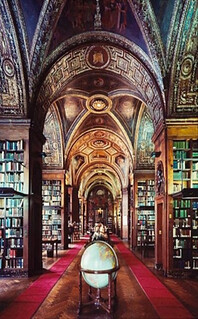 PAN Lecture Series
PAN Lecture Series
Friday, October 25th, 2013
12:00PM- Simcha Kuritzy-“The Temple Tax”
1:00PM– Kevin Flynn- Discussing “The Two, Three Cent Silver and Nickel Series”
2:00PM– Paul Joseph of ANACS- Coin Grading
3:00PM- Jeanne Stevens-Sollman- “The Influence of Coinage on the Medal: How I Began My Medallic Journey”
4:00PM- John Mercanti-“Mint Archives and Digital Technology
For more information about the PAN show, see: www.pancoins.org
AUTHORS MERCANTI AND MOY AT BALTIMORE EXPO NOVEMBER 2013
Coin collectors are in for a rare treat at the 2013 Whitman Baltimore Expo, November 7-10, 2013. Two legends of the modern U.S. Mint—retired director Edmund Moy and retired chief engraver John Mercanti—will be at the show Friday and Saturday. Morning and afternoon presentations and book signings give Expo visitors the chance to meet and talk to these two hobby giants.
“Collecting and Investing in American Gold and Platinum Eagles,” with Edmund Moy
Friday, November 8, 2013
11 a.m. – 12 p.m., Charles Street VIP Suite
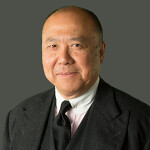 Ed Moy, who served as director of the U.S. Mint during a dramatic period in American bullion coinage (2006–2011), shares his unique insight into the Crash of 2008 and how the Mint responded to the skyrocketing demand for gold. Go behind the scenes at the U.S. Treasury Department and into the back rooms and onto the factory floors of the U.S. Mint! Mr. Moy discusses the nuances of investing in precious metals, and explores fascinating sidebar topics like the $1 trillion platinum coin and the 2009 Ultra High Relief double eagle. Followed by question and answer, and autographs.
Ed Moy, who served as director of the U.S. Mint during a dramatic period in American bullion coinage (2006–2011), shares his unique insight into the Crash of 2008 and how the Mint responded to the skyrocketing demand for gold. Go behind the scenes at the U.S. Treasury Department and into the back rooms and onto the factory floors of the U.S. Mint! Mr. Moy discusses the nuances of investing in precious metals, and explores fascinating sidebar topics like the $1 trillion platinum coin and the 2009 Ultra High Relief double eagle. Followed by question and answer, and autographs.
“American Silver Eagles and the United States Mint,” with John Mercanti
Friday, November 8, 2013
1 p.m. – 2 p.m., Charles Street VIP Suite
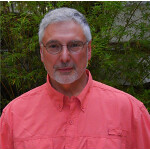 John Mercanti—the designer of the American Silver Eagle’s reverse—shares his first-person perspective on these beautiful and collectible pieces of Americana. Drawing on nearly 40 years of experience working in the U.S. Mint (ending as the Mint’s 12th chief engraver), Mercanti shares memories of famous Mint personalities; discusses the transition from traditional methods to digital and laser technology; explores the creative design process; and comments on the U.S. bullion coin program, modern commemoratives, and great coinage designs of the past. Followed by question and answer, and autographs.
John Mercanti—the designer of the American Silver Eagle’s reverse—shares his first-person perspective on these beautiful and collectible pieces of Americana. Drawing on nearly 40 years of experience working in the U.S. Mint (ending as the Mint’s 12th chief engraver), Mercanti shares memories of famous Mint personalities; discusses the transition from traditional methods to digital and laser technology; explores the creative design process; and comments on the U.S. bullion coin program, modern commemoratives, and great coinage designs of the past. Followed by question and answer, and autographs.
Book Signing With Edmund Moy and John Mercanti
Friday, November 8, 2013
3 p.m. – 4 p.m., Booth #1401
Where can you meet a director of the U.S. Mint and a chief engraver? At the Whitman Publishing booth, of course! Have your picture taken with Ed Moy and John Mercanti, and get your copy of the best-selling American Silver Eagles autographed by these living legends of the U.S. Mint.
“Silver, Gold, and Platinum: Behind the Scenes at the U.S. Mint,” with Edmund Moy and John Mercanti
Saturday, November 9, 2013
11 a.m. – 12 p.m., Charles Street VIP Suite
Join Ed Moy (retired director of the U.S. Mint) and John Mercanti (retired U.S. Mint chief engraver) in a free-wheeling exploration of the American Eagle bullion program, modern coinage, collecting and investing, and other hobby topics. This is a round-table discussion, moderated by Whitman publisher Dennis Tucker, featuring behind-the-scenes stories, advice for collectors, and personal memories from two of the U.S. Mint’s most famous living legends. Bring your copy of American Silver Eagles to be autographed after the round-table.
Book Signing With Edmund Moy and John Mercanti
Saturday, November 9, 2013
2 p.m. – 3 p.m., Booth #1401
Have your picture taken with two superstars of the modern U.S. Mint: retired director Ed Moy and retired chief engraver John Mercanti. Come to the Whitman Publishing booth and get your copy of the best-selling American Silver Eagles autographed while you’re here!
To read the complete article, see: Two legends of the Modern U.S. Mint will be at Expo (expo.whitman.com/news/two-legends-of-the-modern-u-s-mint-will-be-at-expo/)
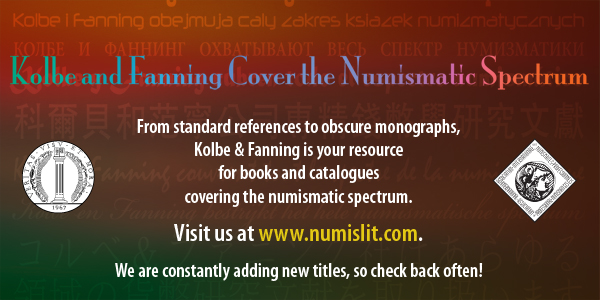
EARLY BECHTLER NEWSPAPER CLIPPINGS
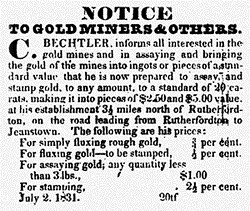 “NOTICE TO GOLD MINERS & OTHERS
C. Bechtler informs all interested in the gold mines and in assaying and bringing the
gold of the mines into ingots or pieces of a standard value, that he is now prepared to assay, and stamp gold, to any amount, to a standard of 20 carats, making it into pieces of $2.50 and $5.00 value, at his establishment 3 ½ miles north of Rutherfordton, on the road leading from Rutherfordton to Jeanstown. The following are his prices:
“NOTICE TO GOLD MINERS & OTHERS
C. Bechtler informs all interested in the gold mines and in assaying and bringing the
gold of the mines into ingots or pieces of a standard value, that he is now prepared to assay, and stamp gold, to any amount, to a standard of 20 carats, making it into pieces of $2.50 and $5.00 value, at his establishment 3 ½ miles north of Rutherfordton, on the road leading from Rutherfordton to Jeanstown. The following are his prices:
For simply fluxing rough gold, ¾ per cent.
For fluxing gold – to be stamped, ½ per cent.
For assaying gold; any quantity less than 3 lbs., $1.00
For stamping, 2½ per cent.
July 2, 1831
The undersigned having coined a great quantity of N. Carolina gold into pieces of $2.50 and $5.00 value, of 20 carats fine, and being well prepared to increase the business to any extent, is established 3 ½ miles on the road leading from Rutherfordton to Jeanstown, invites the attention of miners in S. Carolina and Georgia as well as N. Carolina to the advantage which would result from having the product of their mines coined or made into ingots bearing their just value rather than disposing of it in its fluxed state, without an assay and therefore liable to produce an improper value: gold in a fluxed state of 22 and 23 carats is generally sold for 84 cents per dwt. in the bank, whereas its intrinsic value, if coined, is 90 or 94 cents, consquently an actual saving of 6 cents per dwt will be made by having it coined after paying all the expenses of coining, etc. Should encouragement be given, new dies will be made especially for stamping S. Carolina and also Georgia gold.
He would also here make known the plan which he has adopted and will pur- sue: on receiving a bar of fluxed gold to be coined, the same will be divided, a portion assayed (by a fire ordeal) for the purpose of ascertaining its exact fineness, and he will be accountable for the amount of the value of the whole so ascertained — at the same time returning to the owner ½ dwt of each assay, which he may keep for his own satisfaction or for the purpose of having it assayed elsewhere to find its value, that no deception or fraud may be practiced, and, in case there should be, that he might have the means of detecting the same — for all which he holds himself responsi- ble. The following are his prices: for fluxing 400 dwts or less $1.00; for assying (by a fire ordeal) 1000 dwts or less, $1.00; for coining 2 ½ per cent. When the gold is to be coined no charge is made for the assay.
He has also on hand a handsome assortment of jewelry, watches, etc. Any particular kind of jewelry will be executed to order in the neatest and most skillful manner. C. Bechtler”.
NUMISMATIC LIBRARIES AND ESTATE PLANNING
It was good to read about the shelves of Gordon Frost references at the ANS Library in last week's issue.
Many years ago, Gordon walked up to my club table for IBNS, NI, NBS, etc., at an ANA Convention and looked at the stacks of references on the table behind me that I was giving away. He asked me how I determined who would receive them and we finished talking several hours later. Later, he introduced me to his close friend, John Huffman, and the three of us had many lunches and dinners together at ANA Conventions.
Not long before Gordon passed away, he came up to my club table with a couple of boxes of about 50 references on a small cart. He told me these references needed to find a good home and he was tasking me to find those homes. OK. I must say he was not the only person to give me references but several of his were scarce to rare! I divided the references into many stacks; Asian, Roman, Greek, etc. When I went to a show or event, I would think about collectors who would likely attend it. I would email them and bring one or more stacks with me.
All of the books found a good home except about the last five or six. Then I remembered the youngest member of our monthly Northern Virginia Nummis Nova Dinner group was building his library. So a couple of months ago, I bagged up the last of Gordon's references, plus some extras from my library, and gave them to the young man. I know Gordon is looking down on me and telling me I did the right thing with his donation.
John Huffman and Gordon were very close friends. So close that they could almost finish each other's sentences. After Gordon passed away, John was tasked to sell, donate, etc. Gordon's vast holdings. At the last Nummis Dinner John attended, he was having trouble swallowing his food. A couple of weeks later, I invited him to attend a lunch with on old collector in Washington, DC. He ate very little, but I did not notice at the time because he was having an excellent conversation with my friend. Awhile later, I flew over to my home in Viet Nam. John then sent me an email that he had advanced cancer and he started to disperse his library and coin collections. He completed his task and settled his estate with his family, but he passed away before I returned to the USA to see him one more time.
Both of the above bibliomaniacs had a strong influence on me and what I should do with my personal library. So I started dispersing mine. Most of my non-numismatic books for Indonesia, Singapore, Malaysia, Brunei and the Philippines have gone to the Dalley Book Service, except everything Philippines is going to the CookieJar. The CookieJar owner is Ray Czahor and he has frequent auctions of Philippines-only lots, and George Dalley is an old Laos hand who loves books about Southeast Asia. There are no references in my library that are wanted by the ANA and ANS libraries but I do donate my new books to them.
It was difficult to change from being an accumulator, but I have started the process of lessening my holdings so my executor does not have too big of a job selling and donating it. In a related matter, I try to end all of my talks around the country with a plea to the attendees to please draw up a will and include all of their numismatic holdings in it with the name of a person they trust to dispose of it for them. Too many personal libraries end up in junk book stores or even dumpsters.
To read the earlier E-Sylum article, see: THE FROST SHIPS AND SHIPWRECKS SHELVES AT THE ANS LIBRARY (www.coinbooks.org/esylum_v16n42a06.html)
JOEL OROSZ ON ONE-COIN COIN BOOKS
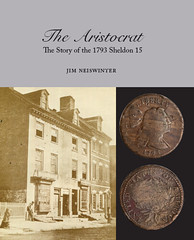 We call them “coin books,” but wouldn’t it be more accurate to say “coins books”? Nearly every such volume covers many coins.
We call them “coin books,” but wouldn’t it be more accurate to say “coins books”? Nearly every such volume covers many coins.
For example, A Guide Book of United States Coins by R.S. Yeoman and edited by Kenneth Bressett, the “Red Book,” catalogs hundreds of different U.S. coins, from half cents to double eagles.
But few volumes — they can be counted on your fingers — are written about just one coin. Such coins are something special, and so are the books that describe them. Buy all nine of them, and you have an impressive mini-library or a dynamite show exhibit.
Best of all, none are rare, so all can be purchased for a total of less than $100. The first, published in 1962, is Eric P. Newman and Kenneth Bressett’s The Fantastic 1804 Dollar, which demonstrated that some of these dollars were made as diplomatic gifts, while others were struck surreptitiously by Mint employees for profit.
Next is Pete Smith’s The Story of the Starred Reverse Cents, published in 1986, which explained the discovery and probable reason for the creation of the variety of 1794 Liberty Cap cents with 94 minute stars encircling their reverse rims.
Only these two single-coin books were written during the first 150 years of coin collecting as a mass hobby in the United States, but for reasons unknown, starting in 2004, the single-coiner pace accelerated to one per year.
- David Enders Tripp’s Illegal Tender: Gold, Greed, and the Mystery of the Lost 1933 Double Eagle (2004)
- Alison Frankel’s Double Eagle: The Epic Story of the World’s Most Valuable Coin (2006).
- Paul Montgomery, Mark Borckardt and Ray Knight's Million Dollar Nickels
- Jack Collins and Walter Breen's 1794: The History and Genealogy of the First United States Coin (2007)
- Martin Logies' The Flowing Hair Silver Dollars of 1794. (2007)
- Dean Albanese’s King of Eagles: The Most Remarkable Coin Ever Produced by the U.S. Mint (2009)
- Jim Neiswinter's The Aristocrat: The Story of the 1793 Sheldon 15. (2013)
To read the complete article, see: Developing a mini-library (www.coinworld.com/articles/developing-a-mini-library)
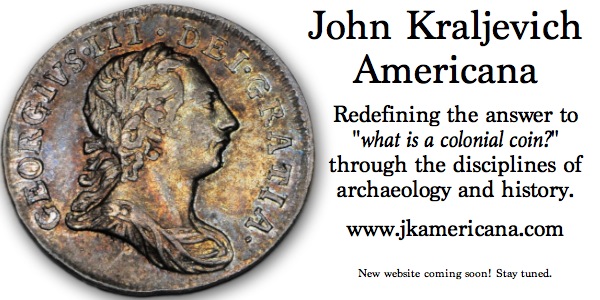
U.S. MINT RESEARCH AT THE NEWARK PUBLIC LIBRARY
For the past several years I've been interested in learning more about mint operations and mint personnel. In the past, I've mostly relied on the various partial lists of mint officers that are in a number of books until I found the Senate Executive Journal on the Library of Congress' website (and elsewhere), which lists the dates prospective Mint officers names were submitted for confirmation and when they were confirmed (or not). Then, a few years ago, I happened upon the Register of all Officers and Agents of the United States (frequently referred to as the Official Register). The Official Register, which has been published in alternate years since 1817, names, as its title indicates, the officers and agents of the United States - Ambassadors, Army officers, postmasters, etc., but especially Mint officers!
Since my interest is primarily in the branch mints, I started accumulating copies of the relevant pages with the volume for 1839, which lists only the officers of each mint. In 1841 the Official Register begins to list some of the clerks as well as the officers and then in 1873 the Official Register begins to list what looks like every employee in each mint! This practice continues until the 1907 edition, which only lists the more senior employees and then, in 1911, the Official Register begins listing only the superintendent. Also, at a certain point, the Official Register splits into two volumes, with Volume Two dedicated to Post Office employees only.
(Perhaps I'm the last researcher in the world to learn about the Official Register, but just in case I'm not and because I'm such a nice person, I thought I'd share.)
Eventually, I tracked down almost all of the editions of the Official Register through HathiTrust (which was mentioned a few weeks ago and hopefully you've memorized the address by now), but I couldn't find 1851, 1895 or 1901 (also 1861 and 1863, but for my purposes, I didn't need them).
Since I work only about six blocks from the Science, Industry and Business Library of the New York Public Library I recently checked with them for the missing copies. As you can imagine, they had some hard copies, but they did have everything on microfiche - all in the bowels of the closed stacks of the main Library at 42nd St.
So I gamely put in a request and they sent a clerk into the depths of the closed stacks to retrieve the microfiche for me. Unfortunately, the microfiche isn't well labeled and the clerk just grabbed the first inch or so off the stack and brought it. A week later I was able to get to SIBL and look at the microfiche. A quick consultation with the reference librarian and the clerk revealed the problem - so I asked for the next inch!
The second batch included 1851, but getting to 1895 and 1901 promised to be a longer process. Also, the microfiche was white-on-black, which is hard on my eyes, so I decided to try an alternate route to find the hard copies.
I called my local library and the reference librarian mentioned that the Newark Public Library is a government documents depository.
I then spoke to the Newark government documents librarian, who promised to get the two volumes I needed (1895 and 1901) and send them up to the reference desk, where I would be able to look at them and make copies. She said that the volumes were the originals and very fragile.
So, last Saturday afternoon I drove the handful of miles to the Newark Library.
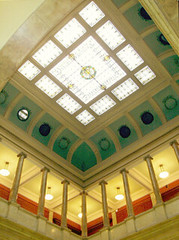 I used to work in Newark (in the very early '90's), but had forgotten how beautiful the original library building is. Here's the Library's "About" page:
www.npl.org/Pages/AboutLibrary/NPLhistory.html
I used to work in Newark (in the very early '90's), but had forgotten how beautiful the original library building is. Here's the Library's "About" page:
www.npl.org/Pages/AboutLibrary/NPLhistory.html
The interior of the central area of the first floor is all marble, with a three-story atrium and a beautiful skylight. There's also a very nice mural on one wall on the second floor. After admiring the interior, I made my way to the reference desk and the two librarians on duty handed me the two volumes - the right years and the right volumes!
They really were the original volumes and fragile isn't the word for them - the covers were separated and I had to blow the paper fragments off the glass plate of the copier each time I made a copy. Plus, the volumes were huge! They were 8 1/2" x 11" and at least four inches thick - they were a lot to manhandle onto and off the copier, as I didn't want to damage them any more than necessary. But, a half hour later or so, I had my copies!
I have to say, I really bless Google and digitization now!
So, for anyone who's near Newark, I highly recommend the Newark Public Library - you can park in the parking lot of the Newark Museum, which is just down the street and visit both in one afternoon! Also, if you have a research question, don't forget to call your local library - the reference librarian will probably relish the challenge!
By the way, back in the July 15, 2007 edition of the E-Sylum, Bob Merchant posted a query about identifying the Chief Coiners of the Philadelphia Mint. I hope he's answered his question in the intervening six years, but, if not, this should do it
To read the earlier E-Sylum article, see: U.S. MINT CHIEF COINER REFERENCE SOUGHT (www.coinbooks.org/esylum_v10n28a05.html)
WAYNE'S NUMISMATIC DIARY: OCTOBER 20, 2013
This Diary's coming a week late, but better late than never. October 8th, 2013 was the night of my northern Virginia numismatic social group, Nummis Nova. Our host was Roger Burdette, and he'd chosen the Jaipur Royal Indian Restaurant in Fairfax, VA. For a change I was the first to arrive, and picked a chair in a cozy private room.
Next to arrive was Howard Daniel. I learned later it was his birthday. As it happened it was also the birthday of Julian Leidman, one of our regulars. Julian couldn't be with us, but others began arriving soon. In addition to me and Howard, attendees included Roger, Joe Levine, Eric Schena, Gene Brandenburg, Mike Packard, Lenny Goldberg, Aaron Packard, Jon Radel, Steve Bishop, Dave Schenkman and Tom Kays, who took a number of pictures for us.
Howard had with him a reproduction of a Ming Dynasty note produced some years ago by the American Numismatic Association. Even though it is greatly oversize, apparently some people have taken to scraping the ink off the back and peddling them as real.. This one was untouched. Howard had purchased it from Joe Boling.
Here are a couple menu contemplation shots, with Mike Packard and Joe Levine on the left, and me at the right, with Eric Schena and Roger Burdette in the background.
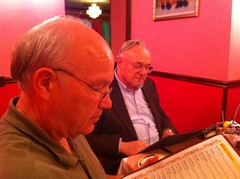
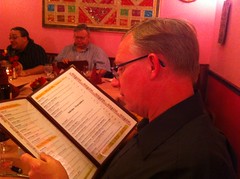
Here's a shot of Jon Radel, who brought along a nice stack of recent numismatic literature, including Collecting Medieval Coins: A Beginner's Guide by Paul A. Torongo. It was the first chance I'd had to see the book in person, and it looks excellent.

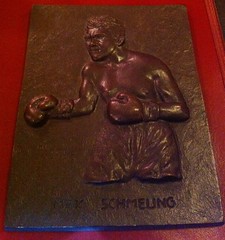 Dave Schenkman brought this plaque of boxer Max Schmeling, who was heavyweight champion of the world between 1930 and 1932, and fought Joe Louis in 1936 and 1938.
Dave Schenkman brought this plaque of boxer Max Schmeling, who was heavyweight champion of the world between 1930 and 1932, and fought Joe Louis in 1936 and 1938.
Eric Schena writes:
Since the theme was numismatic exotica, I brought my collection of letters and correspondence from Virginia banks, the vast majority of which date from 1815 to 1860. What is particularly appealing about these is that each letter details a piece of the daily activities of an Antebellum bank in Virginia, from the mundane (such as receipt acknowledgments for deposits from another bank), to the fascinating (a draft proposal to provide the state a loan of $1.2 million to cover expenses incurred in December 1860).
Some are entirely handwritten, while others are part-printed form letters, while all are unique in their own way. Here are two interesting ones from my grouping.
One is an elaborately printed protested promissory note from the Bank of the Valley in Virginia at its mother bank of Winchester from 1841. What is interesting here is not only the elaborate engraving, but that it is almost entirely printed with only select portions filled in.
The second letter concerns the settlement of an estate in Dandridge, Tennessee in 1839. An attorney in Tennessee sent the Winchester branch of the Farmer's Bank of Virginia a promissory note from 1832 for $300 which was issued there inquiring as to whether or not the decedent had paid off the note. This letter is the reply to that attorney saying it had been paid and included the found promissory note with the letter - in fact the staining on the letter is that of the note. These are little capsules of banking history that are often forgotten.
Here are Eric's images. As always, readers can click on the images to be taken to our Flickr archive, where larger version can be viewed.
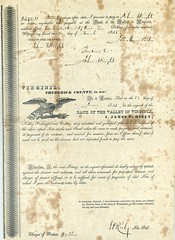
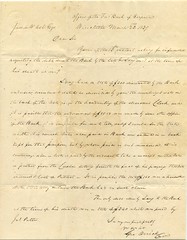
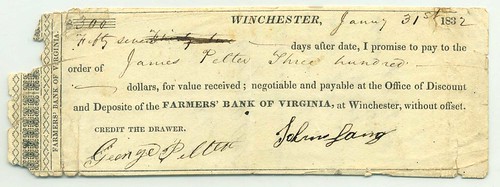
A number of other interesting items were passed around. Thanks again to Tom for taking pictures. Some are fuzzy, but only because I've tried to make some close-ups that stretch the resolution of the camera. Here's a token from the Nonpareil Association Social Club of Baltimore, MD (Rulau MD-Ba 80, Schenkman N60a)
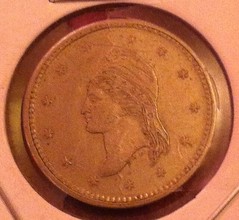
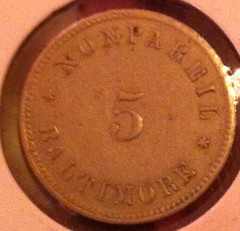
Here are some more shots from around the room. On the left is my view across the table of Gene Brandenburg, our local wine enthusiast, who picked some great selections from the menu. Next to Gene is Dave Schenkman, and again in the background are Eric Schema and Roger Burdette.
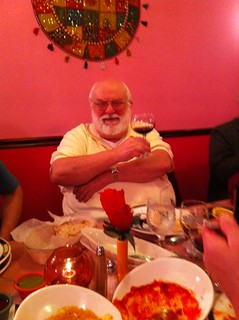
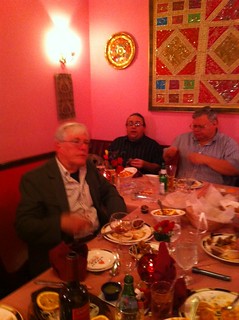
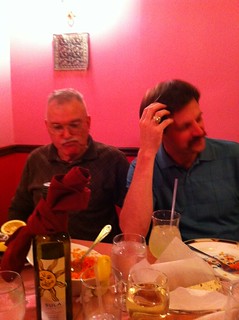 Here are Howard Daniel and Wayne Herndon, likely scratching his head over one of Dave's jokes...
Here are Howard Daniel and Wayne Herndon, likely scratching his head over one of Dave's jokes...
Here's an 1870 beer token from Petersburg, VA.
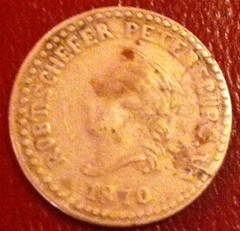
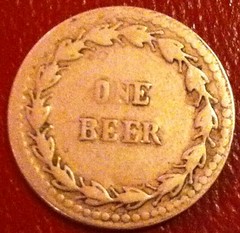
And finally, an 1705 Russian Beard token (well, a copy of Brekke 6). Forgive me if I've gotten the orientation wrong.
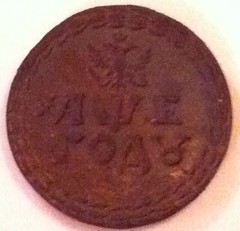

My fun was cut short when I had to leave early to pick up my son at basketball practice. The trip wasn't as fast as I'd hoped; one of Fairfax's Finest pulled me over to politely inquire if I knew how fast I was going. Sorry, didn't have a clue. Did I know what the speed limit on the road was? Uh, no. I figured 50, but kept my mouth shut. Correct answer? 35. Oh, well. I still managed to be on time to pick up my son, but had to mail in a check to pay the fine.
Oh well, the evening was still quite worth it. Thanks again to Tom Kays and Eric Schena for their photos, and Roger Burdette for choosing the restaurant and organizing the evening. It was a great evening!
THE BOOK BAZARRE
THE DAVID SUNDMAN MASSACHUSETTS SILVER COLLECTION
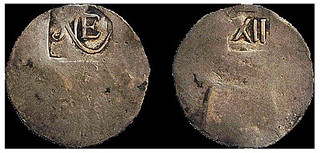 David M. Sundman is especially attracted to coins with a story.
David M. Sundman is especially attracted to coins with a story.
Sundman, the president of Littleton Coin Co. in Littleton, N.H., finds that to be true in all areas of his numismatic collecting. His interests, among other areas, include ancient Greek and Roman silver and gold coins, New Hampshire Colonial and national bank notes, and Massachusetts silver coins.
He also augments his collections with vintage numismatic literature to match his collecting interests. Sundman has decided to bid farewell, however, to his 18-piece collection of Massachusetts silver coins — comprising all major types — to pursue other numismatic collecting interests.
“It’s hard to let things go,” Sundman said in an Oct. 2 telephone interview. “I have so many things that I like to collect. My problem is I like everything. I’m a generalist in most areas of my collecting. I’m attracted to coins with a story. I try to collect in areas that I won’t be competing with my customers.”
Stack’s Bowers Galleries will offer Sundman’s Massachusetts silver coins as part of its Nov. 6 to 9 auction held in conjunction with the Whitman Expo in Baltimore.
While not often the finest known for their types, the coins Sundman acquired were the best available. “This stuff doesn’t trade that often,” Sundman said. “Color is very important. They look the way they should look, with even gray toning. I tried to get the major types in pretty nice condition. I didn’t necessarily get the best, but the best available.”
Growing up in the hobby with Littleton Coin Co., which his father, the late F. Maynard Sundman, founded in 1945, David Sundman said he was well aware of the Massachusetts silver series at a young age.
“It’s imprinted on your brain if you’re from New England,” Sundman said, noting he was intrigued by each coin’s imagery illustrated in A Guide Book of United States Coins. “I appreciate antiquities and the different conditions under which each was produced.”
A number of pieces in Sundman’s collection have served as plate coins in A Guide Book of United States Coins by R.S. Yeoman; in the 1943 monograph, The New England and Oak Tree Coinage of Massachusetts by Sydney P. Noe; in Q. David Bowers’ 2009 Whitman Encyclopedia of Colonial and Early American Coins; and in the 2010 reference, The Silver Coins of Massachusetts by Christopher J. Salmon.
Sundman’s Willow Tree shilling sports an even more extensive pedigree. The shilling is plated in the 1859 American Numismatical Manual by Montroville W. Dickeson. It also graced the collections of Jeremiah Colburn (before 1860), Charles I. Bushnell, Lorin Parmelee, John Mills, George Earle, George Parsons, Henry Chapman, Newcomer and Boyd, before Ford.
“The fact that it can be plate matched to a book in the pre-photographic area makes it one of the longest provenanced of all American coins,” according to early American coin specialist John Kraljevich Jr.
Sundman’s collection spans the Massachusetts silver series from the undated NE (New England) coinage of 1652, continuing through the Willow Tree coins, followed by the Oak Tree coins and then the Pine Tree issues.
To read the complete article, see: Sundman Massachusetts silver to be in sale (www.coinworld.com/articles/sundman-massachusetts-silver-to-be-in-sale)
 David followed up with some additional background on the collection for E-Sylum readers. Thanks! Here he is examining the collection before its sale.
-Editor
David followed up with some additional background on the collection for E-Sylum readers. Thanks! Here he is examining the collection before its sale.
-Editor
I have a lot of “favorites” in the 18 coin collection. In addition to the NE shilling described in the CW article, I really treasure the “Willow Tree shilling” that belonged to Jeremiah Colburn of Boston in 1860, when he loaned to Dr. Montroville W. Dickeson for the latter’s revised 1860 edition of his American Numismatical Manual.
There it appeared as No. 2 on Plate XX, and Dickeson referred to it as an “Oak Tree Shilling,” but the coin’s outline and design is clearly my coin. (Plate XX was not in the 1859 edition of the book.)
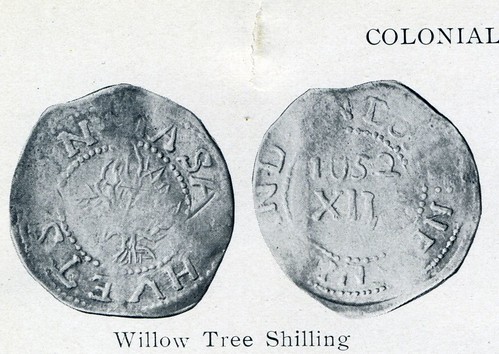
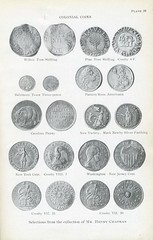
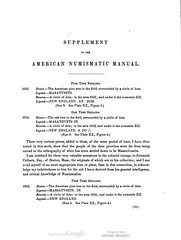
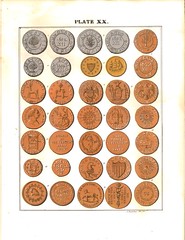
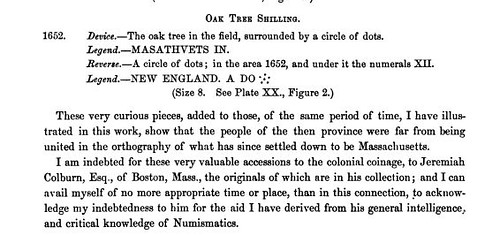
I enjoyed finding my Willow Tree illustrated on plate 39 in the ANS 1914 Exhibition catalogue which I’m lucky to have in my library. The October 2005 Ford Sale lot description for the coin went on to describe the coin’s importance as ….” One of perhaps four known American coins outside the Mint Coll. which can be traced back to 1860 or before, the others being the Abbey cent, Stickney dollar, and 1792 Peter Getz $ 1/2 with the chisel mark” which the Paul Gilkes article references with John Kraljevich’s comment on the coin’s importance .
Thanks to Google Books, E-Sylum readers can read of the 1914 ANS exhibition in New York in the ANS proceedings of February 21, 1914. This was a magnificent exhibition of U.S. and Colonial rarities—unprecedented at the time. Over 5,000 coins were exhibited and in the one month they were on display some 2,408 visitors hardy souls braved heavy snow storms and bad weather to see the exhibit.
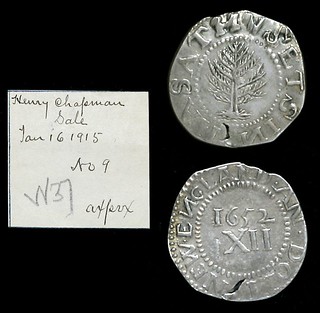 I also attach an image of the Noe-10 Pine Tree shilling. I loved the coin despite its imperfect planchet, and the original lot 9 sales ticket from Henry Chapman’s sale “Catalogue of the Collections of American Coins of George J. Bascom, Esq., and William F. Brown, Esq. January 16, 1915.”
I also attach an image of the Noe-10 Pine Tree shilling. I loved the coin despite its imperfect planchet, and the original lot 9 sales ticket from Henry Chapman’s sale “Catalogue of the Collections of American Coins of George J. Bascom, Esq., and William F. Brown, Esq. January 16, 1915.”
This sale was rated by John Adams as “A-“, and Adams went on to mention “Choice Mass. Silver plus many rare colonials…” in his book, United States Numismatic Literature, Volume 1. This Noe-10 was in the Hain Family Collection sale, Stack’s, Jan 15, 2002 as lot 124. In the upcoming November Stack’s Bowers sale of my collection this is described as “1652 Massachusetts Bay Colony Pine Tree Shilling. Large Planchet. Noe-10, Salmon 8-Diii, W-750. Rarity-3. Without Pellets at Trunk. AU-55 (PCGS). Secure Holder.”
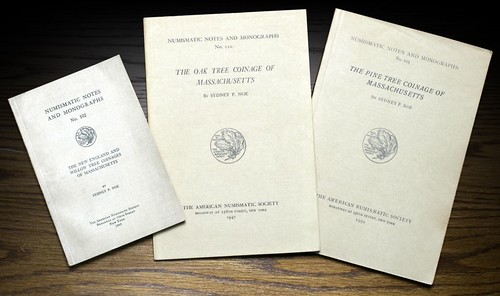
I think collecting and studying and conversing with other collectors about the objects we collect keeps us young. I hope to be collecting and dealing in coins and paper money for a long time to come. Putting together this collection, researching and exhibiting it in Boston at the 2010 ANA ‘World’s Fair of Money’ convention was a lot of fun. Now it’s time to let them go to other U.S. Colonial coin collectors.
To read the 1914 ANS exhibition catalog at Google Books: American Journal of Numismatics, Volumes 47-48
MAUREEN AND STU LEVINE ON NEWMAN’S ORIGINAL SILVER COINS
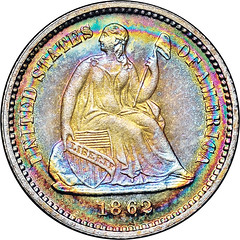
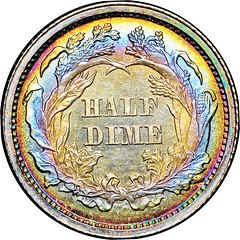
The luxuriously toned surfaces of Eric P. Newman’s silver coins shout out one word: Originality. The 1862 PR68+ * NGC cameo half dime is a prime example. Mirrored fields contrast with frosty devices, creating a beautiful cameo effect. Both sides display stunning, concentric iridescent toning. On the obverse, Liberty is encircled by a rainbow of toning, which highlights her head, passes through her suspended cap, and lightly touches her toe. In our opinion, only the combination of pristine surfaces and long-term album storage results in this smooth, concentric rainbow toning.
To view the complete auction lot description, see: 1862 Half Dime (coins.ha.com/c/item.zx?saleNo=1190&lotIdNo=11627)
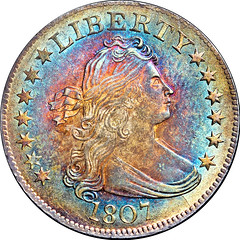
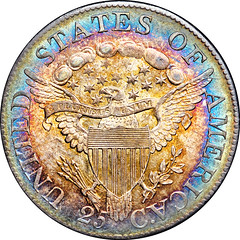
Newman’s early quarter dollars provide more samples of beautiful, original toning. While Liberty and the heraldic eagle seem almost ablaze in the orange and gold centers of the 1807 B-2 bust quarter (MS66 NGC), cool variations of blue ring the peripheries: This is indeed a captivating coin.
To view the complete auction lot description, see: 1807 B-2 Quarter Dollar (coins.ha.com/c/item.zx?saleNo=1190&lotIdNo=11013)
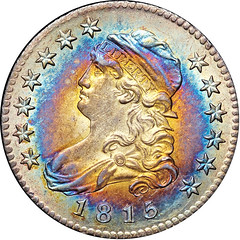
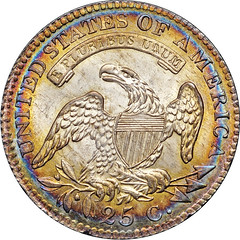
Lady Liberty steals the show on the 1815 B-1 Early Quarter Dollars of the United States Mint plate coin (MS67+ * NGC). Light silver radiates from the obverse center to an area of rich orange-gold toning, surrounded by an inner halo of blue that just misses Liberty’s curls but passes lightly over her Phrygian cap.
To view the complete auction lot description, see: 1815 B-1 Quarter Dollar (coins.ha.com/c/item.zx?saleNo=1190&lotIdNo=11014)
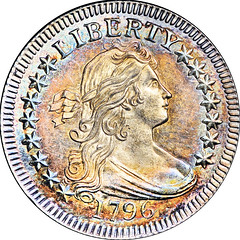
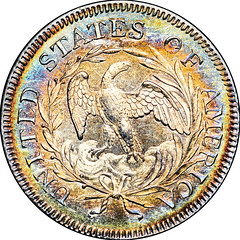
It’s impossible to touch upon the Newman quarter dollars without mentioning the spectacular 1796 B-2, example (MS67+ * NGC). The Heritage cataloger for this lot summed up his thoughts as follows:
The Newman 1796 quarter ranks as the most beautiful surviving example and exhibits quintessential Wayte Raymond album toning, gorgeous gunmetal-blue at the borders, gradually changing through orange-gold to nearly brilliant silver at the centers. The authors of Early Quarter Dollars of the United States Mint chose this coin to illustrate the cover of their book. It is also the plate coin for the die marriage on page 8. The present cataloger has been involved with some of the most important collections to appear in the past quarter century, and chooses this 1796 quarter dollar from the Eric P. Newman Collection as the most beautiful American silver coin that exists today.
To view the complete auction lot description, see: 1796 B-2 Quarter Dollar (coins.ha.com/c/item.zx?saleNo=1190&lotIdNo=11008)
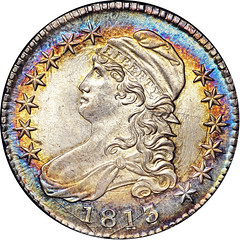
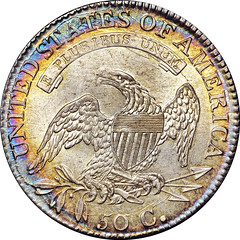
Demonstrations of original toning continue with the half dollars, exemplified by the finest known 1813 Capped Bust O-107a (MS67+ * NGC). The cataloger writes: “The coin is truly "as struck" in terms of luster and preservation, with the joyous addition of iridescent color through the stars and legend. The luminous silver centers are surrounded by champagne-gold and electrified cobalt-blue toning.” Again, this toning is not only gorgeous, but also original.
To view the complete auction lot description, see: 1813 Capped Bust Half (coins.ha.com/c/item.zx?saleNo=1190&lotIdNo=11060)
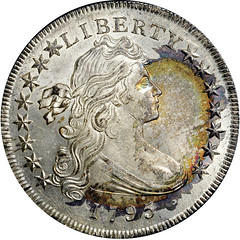
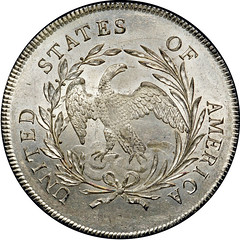
The toning pattern is a little different from the examples cited above on the B-14, BB-51 dollar (MS66+ * NGC), the little masterpiece designed by Gilbert Stuart. While not concentric, this toning is completely charming. A diaphanous area of lovely rainbow toning is seen on Liberty’s face – highlighting her eye and increasing the appearance of a watchful gaze - and accenting her bust, with deeper colors showing in the periphery. This exquisite, original toning complements the unusually superb strike of this piece.
To view the complete auction lot description, see: 1795 $1 Draped Bust, Off Center (coins.ha.com/c/item.zx?saleNo=1190&lotIdNo=11032)
All of the above coins are CAC certified and have the Green-Newman pedigree. Eric P. Newman has attended to them with care for over 70 years. We don’t know how long they were in “Colonel” Green’s possession, but it is evident from their condition that he was an equally fine steward. These coins are original gems. Take the opportunity to see them while you can!
CHINESE TOURISTS DETAINED IN PARIS OVER ONE-EURO COINS
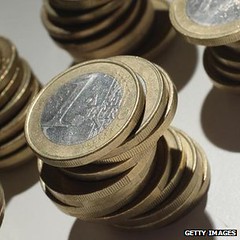 Two Chinese tourists have been briefly held in France on suspicion of forgery after trying to settle their hotel bill with one-euro coins.
Two Chinese tourists have been briefly held in France on suspicion of forgery after trying to settle their hotel bill with one-euro coins.
Police were called in after a hotel owner in Paris became suspicious about the two men, and 3,700 one-euro coins were then found in their room.
But the coins were not counterfeit.
The men said they had got the money from scrapyard dealers in China, who often find forgotten euros in cars sent from Europe.
The hotel owner in Bagnolet, eastern Paris, called the police after the two tourists had tried again to pay their 70-euro (£59) hotel bill for the second night - just like they did the day before.
"Investigators suspected they were dealing with a case of forged currency," a source was quoted as saying by France's Le Parisien newspaper.
But banking experts checked the coins and confirmed that they were not fake.
It was later established that the two men - who have not been identified - had friends in the scrap metal trade in China and bought the coins from them.
Thousands of European cars are shipped to China for scrap every year.
They are meticulously searched before demolition - and it appears that the most common valuables left inside are one-euro coins.
To read the complete article, see: Chinese tourists detained in Paris over one-euro coins (www.bbc.co.uk/news/world-europe-24524699)

STEPPING THE MAST OF THE WHALING SHIP CHARLES W. MORGAN
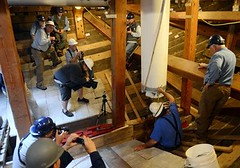 With more than 100 people looking on in the Mystic Seaport shipyard Thursday morning, another milestone was reached in the restoration of the whaling ship Charles W. Morgan as workers reinstalled the first of the ships three masts.
With more than 100 people looking on in the Mystic Seaport shipyard Thursday morning, another milestone was reached in the restoration of the whaling ship Charles W. Morgan as workers reinstalled the first of the ships three masts.
The 68-foot-long, 4-ton foremast dangled from a cable as a massive crane lifted it over the hull and then down between the decks, where it was notched and wedged into place.
Before that occurred, though, 9-year-old Dylan Conforti of Charlestown, Mass., whose grandfather is a former chairman of the museum's trustees, placed a 1941 U.S. Walking Liberty silver half dollar on the spot where the mast would sit. It was in 1941 that the now 172-year-old ship arrived at Mystic Seaport.
Museum President Steve White explained to the crowd that there is a long maritime tradition of placing coins under the base of the mast to bring the ship good luck.
A 1841 U.S. Liberty seated silver dollar representing the year the Morgan was first launched and a 2013 U.S. silver dollar symbolizing the current restoration will be placed under the main mast and mizzen mast when they are installed Oct. 31.
White said the mast installation represents another important milestone in the restoration of the world's last surviving wooden whaling ship and in the preparation of its 28th voyage next summer, when it will sail to historic New England ports.
To read the complete article, see: Whaling ship Charles W. Morgan restores mast with silver half dollar under base for luck (www.theday.com/article/20131017/NWS01/131019743/1017)
SOME STACK'S BOWERS NOVEMBER 2013 BALTIMORE AUCTION LOTS
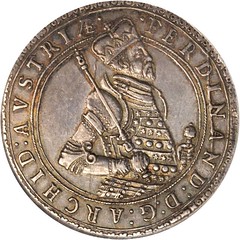
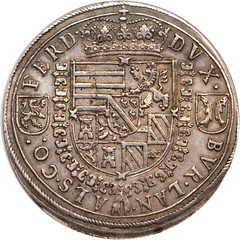
AUSTRIA. Holy Roman Empire. 2 Taler, ND (1564-95)
To view the complete lot description, see: Lot #20142. AUSTRIA. Holy Roman Empire. 2 Taler (stacksbowers.com/Auctions/AuctionLot.aspx?LotID=549873)
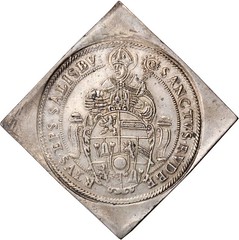

AUSTRIA. Salzburg. Klippe 2 Taler, 1593
To view the complete lot description, see: Lot #20143. AUSTRIA. Salzburg. Klippe 2 Taler, 1593 (stacksbowers.com/Auctions/AuctionLot.aspx?LotID=549874)
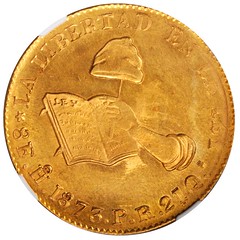
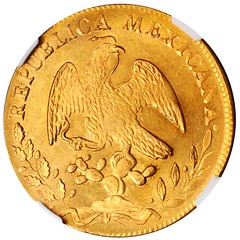
MEXICO. Hermosillo. 8 Escudos, 1873
To view the complete lot description, see: Lot #21112. MEXICO. Hermosillo. 8 Escudos, 1873 (stacksbowers.com/Auctions/AuctionLot.aspx?LotID=550642)

NUMISMATIC SURVEY OF EGYPT AND ALEXANDRIA, PART III
Egypt had three different calendars. The first, civil one was linked to the flooding of the Nile. It was divided into Nile flood, fertile period and time of drought. These three seasons were subdivided into four months with 30 days each; the five days prior to the onset of the New Year were added to that, and that made 365 days in total.
The Egyptian astronomers, however, had realized from time immemorial that the civic calendar was out of step with the astronomical one. For the latter, they took the rise of Sirius, Egyptian Sotis, as fixpoint. It took 364 1/4 days, which meant that after four years the civic calendar differed from the astronomical year for one entire day. It took 1461 years for both calendars to become synchronized again.
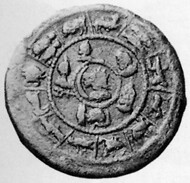
Antoninus Pius, 138-161. Tetradrachm, 144/5. Rev. bust of Sarapis l., surrounded by the busts of the seven planetary gods, outside the twelve signs of the zodiac.
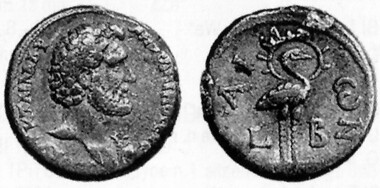
Antoninus Pius, 138-161. Tetradrachm, 138/9. Rev. Phoinix with nimbus.
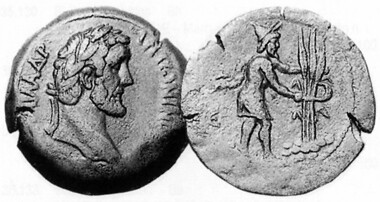
Antoninus Pius, 138-161. Tetradrachm, 141/2. Rv. reaper.
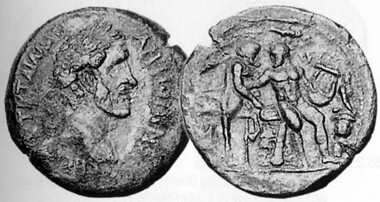
Antoninus Pius, 138-161. Tetradrachmon, 142/3. Rev. Heracles beating his teacher, the centaur Pholos, to death with his lyre.
To read the complete article, see: Egypt and Alexandria. A brief numismatic survey: part III (www.coinsweekly.com/en/Egypt-and-Alexandria-A-brief-numismatic-survey-part-III/8?&id=340&type=a)
EXHIBIT: REFLECTED GLORY: THE ROMANOVS, WÜRTTEMBERG AND EUROPE
At Stuttgart’s Old Castle, an imposing structure steeped in history, a special exhibition entitled ‘Reflected Glory: the Romanovs, Württemberg and Europe’ tells the story of five legendary women whose marriages formed the basis of the extraordinary history shared by the House of Württemberg and the Russian Romanov dynasty. The exhibition runs from 5 October 5, 2013 to March 23, 2014.
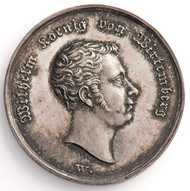
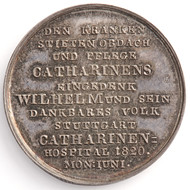 Medal on laying of the foundation stone of the Catherine's hospital.
Medal on laying of the foundation stone of the Catherine's hospital.
For the first time, an exhibition sheds light on the impact of these marriages on European politics, on the domestic and social policies of the two countries as well as on their respective courts.
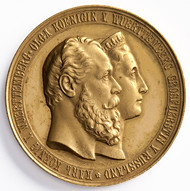
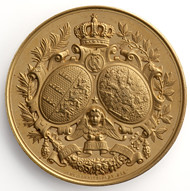 Medal on the silver wedding anniversary of King Charles and Queen Olga of Württemberg.
Medal on the silver wedding anniversary of King Charles and Queen Olga of Württemberg.
Selected art treasures from the Württemberg State Museum and high-profile Russian museums such as the Kremlin or the Pavlovsk and Peterhof imperial palaces reflect pomp, power, splendour and glory, but also homesickness, daily routine, faith and legend.
A comprehensive programme will ensure that the exhibition is a special experience for families. Children aged four to ten can embark on a discovery tour of the ‘Junges Schloss’ children’s museum, where the interactive exhibit ‘Enchanting Russia’ promises fun and adventure from 5 October 2013 to 3 August 2014.
For more information please visit the museum’s website.
To read the complete article, see: Reflected Glory: the Romanovs, Württemberg and Europe (www.coinsweekly.com/en/News/4?&id=2356)
FEATURED WEB PAGE: THE FITZWILLIAM MUSEUM COIN CABINET
This week's Featured Web Page is a 2011 article in CoinsWeekly on the Coin Cabinet in the Fitzwilliam Museum, Cambridge.The Fitzwilliam Museum did not have any money for acquiring objects when it was built. Hence, it was mainly private collections that were given to the museum as a present. In 1860, the famous topographer and archaeologist William Martin Leake bequeathed his coin collection to the museum for the modest sum of 5,000 Pounds.
The money could have been taken from the building funds – a member of the museum advisory board, however, strongly protested against that. His opponent became the archaeologist Churchill Babington who campaigned for the purchase in a booklet. He was a visionary and envisaged that an active coin cabinet would attract further private collections. Yes, he likewise had the many collections in mind which were stored in the different colleges without being cared for. They ought to find a new home in the Fitzwilliam Museum eventually. And they did, although the very last was handed over as loan only recently.
Leake‘s collection is stored in a place separated from the other coins until the present day. The wooden caskets in which some private collections came into the museum are real beauties that contribute to the distinctive atmosphere of the museum’s study rooms.
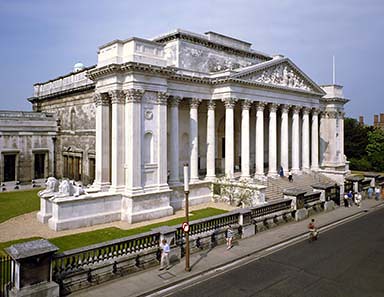
The Coin Cabinet in the Fitzwilliam Museum

